Use [CONTR + F] to search this page and pull down this scroll bar to see everything.
|
|
23-05-1932: ANVV stamps (Tourist Organization). The Moerdijk Railway Bridge near Rotterdam spans the "Hollandsch Diep" (The estuary of the rivers Maas and Waal). The first Moerdijk Bridge was opened on January 1st, 1872. The single-track truss bridge consisted of fourteen arched spans of more than a hundred meters each, which were built on the bank and then sailed to their place. The bridge sections were constructed by the Royal Dutch Van Vlissingen & Dudok van Heel. Part of the bridge on the Brabant side was constructed as a revolving bridge for the benefit of shipping. The bridge was used by the trains, which until the day of opening had their terminus at Moerdijk SS Station at the harbour of Moerdijk on the south side and Willemsdorp on the north side, respectively, a little further away. In the autumn of 1944, the bridge was destroyed by the German occupiers to prevent the Allies from entering the Western Netherlands. During the action, a number of bridge piers were irreparably damaged, which delayed the bridge's recovery enormously. In addition, priority was given to the rapid temporary restoration of the road bridge, for which a number of spans of the railway bridge were borrowed. It was not until 1946 that the restored railway bridge was put back into use. Due to material shortages, the new and modern steel bridge did not have fourteen spans, but only ten spans. The sand dam at the north end of the bridge was extended 400 meters to fill the gap. At the same time, the Willemsdorp stop was closed. The narrow arch leading to the bridge ramp was widened and relocated. [source: wikipedia] The other bridge you see on the stamp is the drawbridge of Schipluiden, which is not a railway bridge of course. The stamps in these series are surcharged for the benefit of the Dutch Tourist Organisation (A.N.V.V.). Several picture postcards were published with the first Moerdijk railway bridge. Have a look at these postcards. Designer: P. Schuitema Photogravure: Enschedé Perforation: L12½ Watermark: 2y Series of 4 stamps. The others being: windmill, townhall and bulbfield. Value: 7½ cents + 3½ cents Circulation: 185,876 Catalogue numbers: / Stanley Gibbons 402 / Michel 251 / Yvert Tellier 243 / NVPH 246 / Scott B56 |
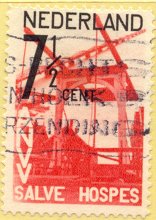 |
|
01-09-1939: Nicolaas Beets, Dutch poet. The Dutch poet Nicolaas Beets (1814-1903) wrote a few poems about the early steam railways in The Netherlands. He was a great fan of the railways. Among others he wrote the following: 
Designer: Kuno Brinks Photogravure: Enschedé Perforation: 12½ x 12 Watermark: none Series of 5 Summer stamps. Circulation: 933,510 Value: 5 cents Valid till: 31-12-1939 Catalogue numbers: / Stanley Gibbons 495 / Michel 330 / Yvert Tellier 321 / NVPH 321 / Scott 219 |
 |
|
01-09-1939: 100 years of Dutch Railways. The first Dutch steam locomotive ran from Haarlem to Amsterdam on 20th September 1839. Its name was De Snelheid (The Speed). It was one of four locomotives which ran the service for the "Hollandsche IJzeren Spoorweg Maatschappij". The other three locomotives were: De Arend (The Eagle), De Leeuw (The Lion), De Hoop (The Hope). They were British made. The Hollandsche IJzeren Spoorweg-Maatschappij or HSM (Hollands Iron Railway-Company) was the first railway company in the Netherlands founded on 8 August 1837 as a private company, starting operation in 1839 with a line between Amsterdam and Haarlem. The company remained operational until 1938, when it merged with the Maatschappij tot Exploitatie van Staatsspoorwegen (SS) to form the Nederlandse Spoorwegen (NS). A replica of the first locomotive is now on show at the national railway museum in Utrecht. The second stamp shows a contemporary electric motor unit (EMU). It is the first streamlined EMU of 1936 design. These units were in service until 1968. Mat '36 (in full: Materieel '36), is the name of electric streamline equipment for passenger transport, as purchased by the Dutch Railways in 1936 to 1942. As with a number of other series, the name is derived from the year in which the equipment was designed and ordered. The shape was based on that of the diesel-electric multiple units of the Mat '34 type, also known as Diesel-three. In total, 90 of these trainsets were built and delivered. The electric streamline stock consisted of a preliminary series Mat '35 of eight two-car sets for the line Rotterdam - Hoek van Holland (in service at the end of 1935) and a number of follow-up series. The Mat '36 series consisted of 53 two-car sets (211-263) and 37 three-car sets (601-637). The originally two-part sets had Jacobs bogies (where two coach bodies rest on a common bogie). The originally three-part sets had a classic support, with each coach body resting on two separate bogies. Due to the electrical and pneumatic connections in the Scharfenberg couplings, the trains could drive in train connection with the trainsets Mat '35, Mat '40, Mat '46 and Mat '54. [source: wikipedia] This was an emission to commemorate 100 years of railways in The Netherlands. Designer: G. Röling Photogravure: Enschedé Perforation: K14¼:13¼ Watermark: 2 Series of 2 stamps. Circulation: 6,062,328 Values: 5 cents and 12½ cents Valid till: 31-12-1939 Catalogue numbers: / Stanley Gibbons 499-500 / Michel 334-335 / Yvert Tellier 325-326 / NVPH 325-326 / Scott 214-215 |
  |
|
28-06-1952: Dutch Post & Telegraph Service Centenary. An emission on the occasion of a hundred years of Dutch stamps and telegraph service. One of a series of four. The other stamps: radio masts and electricity pilons; delivering a letter in 1852; modern postman and houses. The same year this series was issued in different colours: the 2 cents stamp was brown. It was an emission on the occasion of the International Stamp Centenary Exhibition in Utrecht, 28th June up to and including 6th July, 1952. Designer: R.J. Drayer Photogravure: Enschedé Perforation: K13½:14½ No watermark Series of 4 stamps. Circulation: 242,298,000 Value: 2 cents Valid till: 31-12-1953 Catalogue numbers: / Stanley Gibbons 754 + 757a / Michel 593 + 597 / Yvert Tellier 574 + 578 / NVPH 588 + 592 / Scott 332 + 336 |
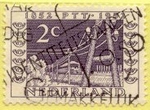  |
|
25-04-1955: Summer Stamps. The Hague post-office annexe railway station and railway viaduct were designed by architect G.C. Bremer. A station post office is a post office in a railway station or in the immediate vicinity of it. A station post office is different from a railway post office. A railway post office is located in a rail car that travels on a specific rail route and loads and unloads mail on the platforms of the stations it serves. That mail is sorted during the journey. A station post office usually also has a sorting center and delivers the sorted mail by train. This mail no longer needs to be sorted on the train. The building in The Hague has a monumental status with number 452783. The detached building was built in representative government architecture, characterized by a traditionalist main design, combined with a contemporary decorative design. Partly influenced by contemporary German architecture, we see in this office building a reference to classicism, which is reflected in the symmetry, the risalites and the mansard roof. However, there is a contemporary design in the detailing in which the ornament is made sparingly and subordinate to the architecture. Expressionism and Art Deco influence can be found in the sculpture and ornamental ironwork. The sculpture is by J. van Lunteren. Sculpture can be found, among other things, on the entrance bay where four relief statues have been placed between the windows at the level of the attic floor. [source: Rijksdienst voor het Cultureel Erfgoed] The Amsterdam Exchange was designed by architect Berlage. This stamp is included because of the tram lines which run in front of it. The Dutch postal service issued an information leaflet on The Hague's station and post office in Dutch. It is here (opens in a new tab or window). Designer: A. Fredericks. Photogravure: Enschedé Perforation: K12:12½ and K12½:12 No watermark Series of 5 stamps. Circulation: 598,411 and 698,197 Value: 5 + 3 cents and 7 + 5 cents Valid till: 31-12-1956 Catalogue numbers: / Stanley Gibbons 811 + 812 / Michel 656 + 657 / Yvert Tellier / NVPH 656 + 657 / Scott B277 + B278 |
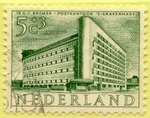 
|
|
28-07-1964: 125 Years of Dutch Railways Jubilee. On the occasion of 125 years Dutch railways there was an emission of two stamps. The first is a picture of a modern station safety light. The signalling system used in the Netherlands was introduced as signalling system 1955. Compared to the signalling systems abroad, this Dutch signalling system is very simple. The meanings of signals are therefore easy to read. It's a speed setting system. Dutch signals usually show only one light, namely green, yellow or red. A green or yellow light is sometimes combined with a number. The numbers indicate speeds in tens of km/h. A number with a green light means that the signal may be passed at that speed; a number with a yellow light means that the speed must be limited to that value and must be reached by the next signal at the latest. The signs along the track that indicate the maximum speed on the track section in question are also part of this signaling system. The other is a 1964 electric train, the so-called Dog's Head, in motion. These EMU's of the 501 series have eight 34 kW traction engines, fed by 1500 Volts AC overhead contact wires. They drove up to 140 kilometres an hour. The rolling stock consisted of independent four- and two-piece trainsets, officially designated as Plan T and Plan V. The name Mat '64 is an unofficial designation. Plan V was for years, with 246 units (although only 245 were present at the same time), the largest rolling stock series of the NS, until the arrival of the V-IRM. A number of trainsets were leased to and used by various regional carriers. Mat '64 was in service on the Dutch railway network for 55 years, from 1961 to 2016. [source: wikipedia] The Dutch postal service issued an information leaflet on this jubilee in Dutch. It is here (opens in a new tab or window). Designer: C. Oorthuis Photogravure: Enschedé Perforation: K14:12¾ No watermark Series of 2 stamps. Circulation: 29,250,500 ; 3,745,500 Values: 15 cents and 40 cents Valid till: 31-12-1965 Catalogue numbers: / Stanley Gibbons 976-977 / Michel 824-825 / Yvert Tellier 798-799 / NVPH 818-819 / Scott 425-426 |
 
|
|
09-04-1968: Summer Stamps. There were tram rails on St. Servaas Bridge in Maastricht from 22 April 1896 till the end of World War I (1918). Tram service ended on 14 August 1914. Sint Servaasbrug (or the St. Servatius Bridge) is an arched stone footbridge across the Meuse River in Maastricht. It is named after Saint Servatius, the first bishop of Maastricht, and (despite being largely rebuilt after World War II) it has been called the oldest bridge in the Netherlands. The Culemborg Railway Bridge in a series of 5 bridges, an emission of summer stamps. The first bridge on this site was built between 1863 and 1868, during the construction of the Utrecht - Boxtel railway line, also known as Staatslijn H. On November 1, 1868, the Utrecht-Kuilenburg section was put into service. This railway was built by law at the expense of the State. The decision to do so was taken in 1860. The construction of the railway line and the design of the bridge were in the hands of engineer Gerrit van Diesen. This first bridge was a real industrial construction: in order not to hinder shipping, no pillars were placed in the river, so the main span was given a length of 154 meters, the longest span in Europe for many years. After World War II the iron bridge was replaced by a steel one. [source: wikipedia] Several picture postcards were published with Culemborg railway bridge. Have a look at these postcards. Designer: R.J. Draijer Photogravure: Enschedé Perforation: K14:12¾ No watermark Series of 5 stamps. Circulation: 1,825,552 Value: 20 cents + 10 cents Valid till: 31-12-1985 Catalogue numbers: / Stanley Gibbons 1050-1052 / Michel 894-896 / Yvert Tellier 866-868 / NVPH 901-903 / Scott |


|
|
26-02-1975: Amsterdam underground lines on Amsterdam Anniversary stamps. When the new Amsterdam metro system had to be built, several Amsterdam buildings would have to disappear. This was the cause of several protest demonstrations which ended up in riots. The first stamp shows the area where the then new Amsterdam underground railway system was to be built. This stamp commemorates the fact that Amsterdam was founded 700 years ago. The second stamp represents the underground railway lines on the map of Amsterdam in its design stage. The building in this stamp is the then 300 years old Portuguese synagogue. The picture of a metro on the top right hand side of my homepage leads to a wikipedia page about the Amsterdam metro in English. Designer: Paul Mijksenaar and Jan van Toorn Photogravure: Enschedé Perforation: K12¾:14 No watermark Series of 3 stamps. Circulation: 4,706,800 and 6,178,200 Value: 30 cents (twice) Valid till: 31-12-1985 The first stamp also appeared with two-sided perforation, circulation: 3,832,000 Catalogue numbers: / Stanley Gibbons 1205-1206 / Michel 1043-1044 / Yvert Tellier 1014-1015 / NVPH 1064-1065 / Scott 522-523 |
 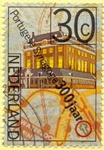
|
|
01-04-1975: Underground lines on Amsterdam Anniversary stamp (Revaluation). The metro area stamp above was revalued to 35 cent. For information on this stamp see above. Designer: Paul Mijksenaar and Jan van Toorn Photogravure: Enschedé Perforation: K12¾:14 No watermark Circulation: 19,960,600 Valid till: 31-12-1985 Value: 35 cents The stamp also appeared with two-sided perforation, circulation: 6,590,800 Catalogue numbers: / Stanley Gibbons 1207 / Michel 1045 / Yvert Tellier 1017 / NVPH 1067 / Scott 524 |

|
|
26-08-1980: Traffic and Transport. In the traffic and transport series, rail transport is represented by the UCES type silo wagon. The bulk silo wagons are intended for the transport of dry, powdery materials, such as fly ash. With the help of a compressor, the cargo is blown through pipes into the tanks. International codification is used to indicate what type of freight wagon it is. These codes consist of one capital letter that indicates the type of car (so-called category letter) and an unlimited number of lowercase letters that indicate the characteristics of the car. Only wagons with the designation "RIV" are allowed for international transport within Europe; these must bear standard inscriptions. The UIC (Union Internationale des Chemins de fer) has created a code for the typing of various cars. The UIC was founded on October 20, 1922 with the aim of standardizing the technical requirements for rolling stock of European railways, promoting cooperation between the railway companies and thus facilitating cross-border rail traffic. The wagon in the stamp has code UCES. Designer: Ben Bos Photogravure: Enschedé Phosphorescent paper. Perforation: K13½:12¾ No watermark, Series of 3 stamps. The other two are: trucks and lorries; cargo barge Value: 60 cents Circulation: 10,751,600 Catalogue numbers: / Stanley Gibbons 1343 / Michel 1166 / Yvert Tellier 1136 / NVPH 1205 / Scott 603 |

|
|
14-10-1980: Dr. Kuyper, prime minister in 1903, who caused a railway strike. Dr. Abraham Kuyper was prime minister from 1901 till 1905. In 1903 a bill was passed which forbade civil servants and workers in public services, among others railway personnel, to strike at all times. These so-called Strangling Laws were so hated by the workers, that they proclaimed a strike among railway workers. Designer: Gielijn Escher. Photogravure: Enschedé Phosphorescent paper. Perforation: K13¼:12¾ No watermark, Circulation: 10,588,600 Value: 50 cents Valid till: 30-06-2002 Catalogue numbers: / Stanley Gibbons 1347 / Michel 1170 / Yvert Tellier 1140 / NVPH 1209 / Scott 607 |
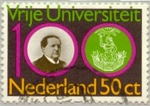
|
|
20-10-1981: Export Stamps. In the Export series, the 45 cents stamp shows us a black-and-white image of Kijfhoek shunting area, surrounded by a ship's propeller and an excavator. Kijfhoek is a shunting yard between Barendrecht and Zwijndrecht. It is 50 hectares, has a two-track hill and has 14 arrival tracks, 43 dividing tracks, all with rail brakes, and 12 departure tracks. Kijfhoek has a capacity of 4,000 freight wagons per day. The shunting yard is located in the municipality of Zwijndrecht. The construction of the shunting yard began in 1975. It was put into use on May 21, 1980 and is named after the present hamlet of Kijfhoek. Kijfhoek has been considerably modernized with the arrival of the Betuweroute. In addition to ATB-EG, ERTMS level 1 was installed on several through tracks in 2014. Kijfhoek is an important link in the distribution of goods from the port of Rotterdam to the European hinterland. The trains are assembled at Kijfhoek in the so-called hill process. The Rotterdam port railway connects the Maasvlakte with Kijfhoek and from Kijfhoek freight wagons can go to Rotterdam or Dordrecht from where the whole of the Netherlands and Belgium can be reached. The Betuweroute provides a connection to the Central and Southern European hinterland. In 2004 approximately 200,000 wagons were handled at Kijfhoek, of which approximately one third contained hazardous substances. The shunting yard replaced the older shunting yards Feijenoord, IJsselmonde, Rotterdam-Noordgoed, but also took over tasks from Amsterdam-Rietlanden, Watergraafsmeer and the marshalling yards of Amersfoort, Onnen and Zwolle. The traffic control post of Prorail is located at Kijfhoek, from where the entire Betuweroute is controlled. [source: wikipedia] Designer: Ch.A. Jongejans. Photogravure: Enschedé Phosphorescent paper Perforation: K14:12¾ No watermark, Series of 4 stamps. The other three are: seaport; airport; clover-leaf junction Value: Circulation: 10,749,900 Catalogue numbers: / Stanley Gibbons 1365 / Michel 1189 / Yvert Tellier 1159 / NVPH 1228 / Scott 616 |
 |
|
06-05-1985: Resistance and Liberation. A lot of Dutch civilians, both men and women, were taken prisoner by the Japanese in the former Dutch Indies - the modern republic of Indonesia - and put to work on the Birma railway line. Thousands were killed during the construction, both of exhaustion and of cruelty from the part of the Japanese. 15 August 1945 is the date that "Indonesia" was liberated. The Burma-Siam Railway, also known as Burma Railway, nicknamed Death Railway, is the railway between Nong Pladuk in Thailand and Thanbyuzayat in Myanmar (Burma), built in Japan-controlled area in World War II from 1942-1944 (Thailand had after invaded, entered into a military alliance with Japan in 1942; Burma was part of the British Empire that was conquered by the Japanese in 1942 to use as a springboard to invade India; it did not get that far). The Japanese forced Allied prisoners of war and forced laborers to do this work. Work on the railway began on September 16, 1942 and was completed 16 months later, despite calculations by Japanese engineers that it would take a minimum of 5 years to construct the 415 km long and 1 meter wide railway. The first train to cross the line was a brothel train for Japanese officers. During construction an average of 75 workers died per day; 15,000 prisoners of war died of exhaustion, disease and malnutrition. They included 7,000 British, 4,500 Australians, 131 Americans and nearly 3,000 Dutch. Western prisoners of war included many KNIL soldiers and Dutch from the then Dutch East Indies. About 100,000 Thai and Indonesian romushas, as well as Burmese and Malaysian forced laborers, died in the construction through the difficult area. After the completion of the railway in December 1943, the work consisted of maintenance and repair of damage from Allied bombers. The labour camps were often located next to vital points of the railway, as a result of which bombings also caused many victims and injuries among the forced labourers. The dead, who were initially buried along the railway, were later reburied in three war cemeteries: Chungkai and Kanchanaburi in Thailand and Thanbyuzayat in Burma. These were created on the initiative of the Commonwealth War Graves Commission, the British sister organization of the Dutch War Graves Foundation. In the west, the railway is mainly known from the movie The Bridge on the River Kwai. Two bridges have been built, a wooden auxiliary bridge and the actual bridge made of steel. In 1945 they were bombed from airplanes. Only the steel bridge has been rebuilt. The river was called Mae Klong at the time of the bridge's construction, but was renamed Khwae Yai in the 1960s when the bridge became internationally known through the film. [source: wikipedia] Dutch postal services issued a magazine called Pro-Fil. Pro-Fil number 16 dealt with these stamps. (article in Dutch) Designer: Pieter Brattinga Photogravure: Enschedé Phosphorescent paper Perforation: K14:12¾ No watermark, Series of 4 stamps. Value: 70 cents Circulation: 15,154,700 (sheet) and 2,035,000 (roll) Catalogue numbers: / Stanley Gibbons 1464 / Michel 1273 / Yvert Tellier 1243 / NVPH 1332 / Scott 668 |

|
|
20-06-1989: 150 Years of Dutch Railways. On the occasion of 150 years of Dutch Railways, there was an emission of a series of three stamps. We see: a rail with a flange wheel; a line-up of old and new railway equipment: steam engines, diesel engines and electric engines as well as EMU's; a statue of lovers taking leave of each other at a railway station. Robert Nakata of Studio Dumbar included Rodin's sculpture "the kiss." There was a celebration of this jubilee called Trains through Time, a manifestation of train equipment in Utrecht. From 22 June to 6 August 1989, a site was demarcated on the Jaarbeurs side of Utrecht CS on a number of tracks that were hardly in use anymore, where all kinds of railway equipment was set up. From old to very new and from 'private' ownership to NS rolling stock. There was also a large exhibition with various themes on display at the Utrecht Jaarbeurs at the same time. The equipment exhibition and the exhibition in the Jaarbeurs together formed the manifestation Trains through Time. The event started on September 6, 1988 with a ride of the professionally restored NS 3737 through the Netherlands from Amsterdam C.S. Numerous foreign and private railway equipment were also invited, which made special journeys throughout the Netherlands. The steam locomotives could be seen almost every day at a steam locomotive parade at the former post platform. During this exhibition, the Blokkendoos museum train set, consisting of the mBD 9107 and the Ces 8104, shuttled between Utrecht CS and Utrecht Maliebaan (the Railway Museum, the home base of this train set) during this exhibition. [source: wikipedia] Dutch postal services issued a magazine called Pro-Fil. Pro-Fil number 56 dealt with these stamps. (article in Dutch) Designers: Donald Janssen, Paul Mijksenaar , Robert Nakata. Offset: Enschedé Phosphorescent paper Sheets of 10 x 10 stamps with synthetic gum. Perforation: 13¼: 12¾ (55 / 65 c) and 14:12¾ (75 c) No watermark, Series of 3 stamps. Value: 55, 65 and 75 cents Circulation: 9,128,300 ; 11,632,450 ; 12,240,800 Catalogue numbers: / Stanley Gibbons 1557-1558-1559 / Michel 1366-1367-1368 / Yvert Tellier 1336-1337-1338 / NVPH 1430-1431-1432 / Scott 746-747-748 |
 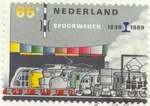  |
|
06-08-1996: Holland Water Country: Erasmus Bridge. The Rotterdam Erasmus Bridge is incorporated because of the railway (tram / streetcar) lines running across it. The rails are part of the city's underground/tram system. Also see the 14-03-2001 issue of priority stamps with the same bridge. Erasmus Bridge is, next to the Willemsbrug, the second bridge over the Nieuwe Maas in the center of Rotterdam. It is named after the Dutch priest and humanist Desiderius Erasmus (Rotterdam, 28 October 1466, 1467 or 1469 – Basel, 12 July 1536). The bridge connects the "Kop van Zuid" district with the center on the north side of the river. The 284 meter long cable-stayed bridge designed by architect Ben van Berkel (UNStudio) has a 139 meter high bent asymmetrical steel pylon. The bridge owes its nickname "De Zwaan" (The Swan) to this. Designers: Jan Kees Schelvis Offset: Enschedé paper: phosphorescent Perforation: 13¼:12¾ No watermark series of 3: the other 2 being: Nijhoff Road Bridge and Wijker Tunnel Value: 80 cents Circulation: 8,000,000 Catalogue numbers: / Stanley Gibbons 1807 / Michel 1587 / Yvert Tellier 1550 / NVPH 1689 / Scott 937 |
 |
|
07-09-1999: Stork Machine Company. The photograph at the bottom shows part of the former workshop of Stork, a company which produces components for metro and other rail companies. The stamp has been issued to celebrate the centenary of Dutch Employers' Associations VNO and NCW. Founded in 1865, Stork is a Netherlands-based company with headquarters in Utrecht. During the Second World War, 500 workers from Stork were employed by the occupying forces as forced laborers in Germany. After the liberation, the reconstruction brought a period of growth. Stork employed 6000 people at one point. Yet it was found to be too small. That is why Stork merged with Werkspoor in Amsterdam in 1954. The combination was called United Machine Factories (VMF) and had 10,000 employees. Werkspoor N.V., the abbreviated and later the official trade name of the Koninklijke Nederlandsche Fabriek van Werktuigen en Spoorwegmaterieel, was a Dutch machine factory, known for its steam engines and rolling stock. The company was founded in 1827 by Paul van Vlissingen (1797-1876) and Abraham Dudok van Heel (1802-1873) with the support of King Willem I. Around 1850 Werkspoor was the largest machine factory in the Netherlands. The company then had approximately 1000 employees. Among other things, steam engines, steam boilers and machinery for the sugar industry were manufactured, and from 1843 to 1846 also some steam locomotives. During this period, the factory was awarded the Royal designation. The company depended in part on government orders. In 1871, the company was reorganized because of financial difficulties during the construction of the Moerdijk Bridge. The new company, a public limited company, was named Koninklijke Fabriek van Stoom- en andere Werktuigen. Around 1890 this company also got into trouble. It was continued from 1891 with financial assistance from the machine factory Stork as the Nederlandsche Fabriek van Werktuigen en railway equipment. The production of the latter product was initially limited to railway wagons and the like, but in 1897 the company received an order from the Nederlandsch-Zuid-Afrikaansche Spoorwegmaatschappij for 40 locomotives in addition to 400 freight wagons. To this end, three large factory halls were built on Oostenburg in 1897, designed by the architect A.L. van Gendt. In 1913, the manufacture of railway carriages and steel structures moved to the industrial estate on Cartesiusweg. A new factory complex, which in its heyday employed nearly 6,000 jobs, was built there. Nieuw-Zuilen, including the Elinkwijk and De Lessepsbuurt neighbourhoods, was created to house the employees. In the first years after the liberation, Werkspoor had a lot of work to repair damaged Dutch rail and tramway equipment. Many locomotives, railway carriages and trainsets were also built for the benefit of the Dutch Railways. In many cases these orders had to be shared with the other Dutch railway industries Beijnes and Allan. Due to the independence of Indonesia, the Dutch East Indies had disappeared as a sales area for Werkspoor's rolling stock, but in 1951, partly thanks to the international contacts of Prince Bernhard, a large order (90 locomotives and 400 carriages) was acquired from Argentina worth 225 million guilders. This took seven years to complete, during which time the factory staff was expanded from 2,000 to 5,000 men. In 1954 the company merged with Stork and continued to exist as part of the United Machinefabrieken Stork-Werkspoor (VMF). A new large factory hall was built in Utrecht in 1960 for the construction of large boilers and appliances, the Apparatenhal, also known since 2013 as the Werkspoor Cathedral. Around 1968 Werkspoor had so many orders, including the construction of the NS train sets Plan V and a large series of Amsterdam trams, that work was outsourced to the German manufacturer Düwag. Nevertheless, the rolling stock department (Rolma) had little future prospects, because after the expiry of the Argentinian order the company only supplied the Dutch market. The management closed the Rolma department in 1972. Trainset 840 of the NS is the last rolling stock built (delivered in 1972). In 1989 Stork-Werkspoor-Diesel (SWD) was taken over by the Finnish concern Wärtsilä. [source: wikipedia] The Collect Club of Dutch postal services issues a magazine called Collect. Collect 1999-21 dealt with this stamp. (article in Dutch) Designer: Titus Swart Photograph: Joost Guntenaar print: Offset by JESP paper: phosphorescent Perforation: 13¼:12¾ Watermark: no Circulation: 5,500,000 Value: 80 cents valid till: 30-06-2002 Catalogue numbers: / Stanley Gibbons 1962 / Michel 1736 / Yvert Tellier 1709 / NVPH 1838 / Scott 1036 |
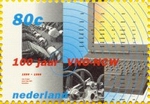 |
|
04-03-2001: priority sheet: Rotterdam European cultural capital. The stamp shows Erasmus Bridge in Rotterdam. A bridge with tram tracks on it (part of the city's tram-underground system). The same bridge was also to be seen on a 1996 Dutch stamp. Designers: Armand Mevis and Linda van Deursen print: Offset: Joh. Enschedé paper: phosphorescent Perforation: slitform Watermark: none Glue: self-adhesive Value: 5 x 110 cent, including 5 priority stickers Circulation: -- Catalogue numbers: / Stanley Gibbons 2095 / Michel 1861 / Yvert Tellier 1824 / NVPH 1967 / Scott 1066 |
 |
|
21-05-2002: surprise sheet for the province of Groningen: Groningen Museum. The fourth decoration field from the top shows the Groningen Art Museum. At first sight it has no connection whatsoever with railways, but the caption in this decoration field says: "Bridge between Central Station and City Centre". The mention of the railway station is the only reason why this stamp is shown here. Designers: Vandejong and VanGOG-designers, Amsterdam print: Offset, the House of Questa, England paper: phosphorescent Perforation: 14½:14¾ Watermark: none Glue: synthetic Value: 12 x 0,39 Euros Circulation: 100,000 sheets Catalogue numbers: / Stanley Gibbons V6 / Michel KB2009 / Yvert Tellier 1933 / NVPH E462 / Scott |
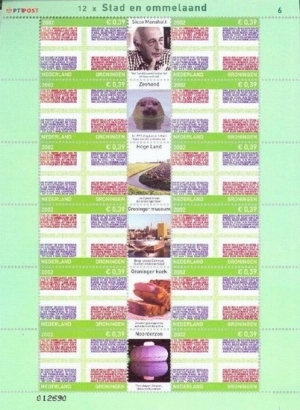  |
|
18-06-2002: surprise sheet for the province of Utrecht: railway museum, Utrecht. The fourth decoration field from the top shows the National Railway Museum, Maliebaan Station, Utrecht. The twelve stamps are all the same: the Utrecht provincial flag. TPG Post, our national postal service, introduced 13 sheets, one for each Dutch province. They can only be bought at the post offices in the province they are meant for. And only for a very short period, and no more than three sheets per customer. Thus they are very hard to get by. Utrecht Maliebaan station is a station built in 1874 on the Hilversum-Lunetten railway line. The Dutch Railway Museum has been located in the station building since 1954. Until the end of 2012, the station had two tracks on an island platform along the through track and a head track from the direction of Lunetten. Due to the demolition of the tracks in the direction of Lunetten, Maliebaan station has actually become a terminus, of which only one track is still in use, accessible from the direction Blauwkapel. The Maliebaanstation is a national monument. The station was built by the Hollandsche IJzeren Spoorweg-Maatschappij (HIJSM). Construction started on September 4, 1873 by contractors J. Verwaayen and J. Kooy from Arnhem. The architect is probably A.L. van Gendt. The layout of the station is very similar to the now demolished Hilversum station, which was built in the same period. Since its opening in 1874, the number of travellers using this station has not been large. The station was already renovated in 1887, in favour of freight transport. This was reinforced again in 1908, when the entire south wing was converted into a storage place for delivery and cargo goods. After HIJSM and SS merged in 1938 to form N.V. Nederlandse Spoorwegen, Maliebaan station was considered redundant and closed on October 15, 1939. Due to a derailment the station was temporarily used again as a station on and around 2 February 1940. During the Second World War, Maliebaan station was specially reopened to deport the Utrecht Jews to Camp Westerbork and from there to the extermination and concentration camps. In 2015, a memorial was erected on Johan van Oldenbarneveltlaan in front of the former station for the 1,239 Jewish victims from the city of Utrecht. In 1954 the building was given a new purpose as the Dutch National Railway Museum. [source: wikipedia] The site of the Utrecht Railway Museum is here. Designers: Vandejong and VanGOG-designers, Amsterdam print: Offset, the House of Questa, England paper: phosphorescent Perforation: 14½:14¾ Watermark: none Glue: synthetic Value: 12 x 0,39 Euros Circulation: 100,000 sheets Catalogue numbers: / Stanley Gibbons V8 / Michel KB2023 / Yvert Tellier 1947 / NVPH E464 / Scott |
  |
|
25-11-2004: personalised (official) December (Christmas) stamp In this case it is the tab that shows a railway related subject, not the stamp itself. In the tab you can see the steam locomotive from the Harry Potter books. The locomotive headed Hogwarts Express, which carried wizard pupils from London's Kings Cross railway station platform 9½ to Hogsmeade, where Hogwarts School of Witchcraft and Wizardry is situated. The steam engine used in the film adaptations is the GWR 4900 Class 5972 Olton Hall, but it was not the first real locomotive to be disguised as the Hogwarts Express. To promote the books, the Southern Railway locomotive Taw Valley was repainted and renamed temporarily, but was rejected as looking ‘too modern’ for the film. Designers: Eat print: offset, Joh. Enschedé paper: non-phosphorescent with phosphorescent beam Perforation: 13½:12¾ Watermark: none Glue: ? Value: 10 x 0,29 Euros Circulation: - Catalogue numbers: / Stanley Gibbons 2380 / Michel 2274 / Yvert Tellier 2178 / NVPH 2316 / Scott |
 |
|
12-04-2005: Beautiful Netherlands (Mooi Nederland) sheet: Rotterdam In this sheet, which was available only in the city of Rotterdam and from the postal services website (Collect Club), you can again see Erasmus Bridge (with tram rails). Erasmus Bridge has already been discussed above. Designer: Esther de Vries print: offset, Joh. Enschedé paper: non-phosphorescent with phosphorescent beam Perforation: 14½:14¼ Watermark: none Glue: ? Value: 5 x 0,39 Euros Circulation: - Catalogue numbers: / Stanley Gibbons V15 / Michel 2308KB / Yvert Tellier 86 / NVPH 2340 / Scott 1187 |
 |
|
14-06-2005: Beautiful Netherlands (Mooi Nederland) sheet: Goes This sheet shows the still operational steamtram Goes-Borsele in the Dutch province of Zeeland. The sheet was only available from the Goes post offices and the TPG post website (Collect Club). The Foundation Steam Train Goes-Borsele (SGB) operates a tourist train in South Beveland in the province of Zeeland. In the twenties of the twentieth century, the Spoorweg-Maatschappij Zuid-Beveland constructed several tram lines from Goes. These were opened in 1928 and operated by motor vehicles. Passenger transport was discontinued after a few years. Freight transport continued to exist. The lines to Wemeldinge and Wolphaartsdijk were closed and broken up in 1942. The lines to Hoedekenskerke and Borssele (municipality of Borsele) remained in use for freight transport until 1972. The western line from 's-Heer Arendskerke in the direction of Borssele was extended to port rail line (Oude Sloelijn) to the Sloe area and was run by freight trains, but was broken up after the New Sloeline was put into use in 2007. A museum service has been run on the eastern line since 1972 by Steamtram Goes-Borsele, founded in 1971. It was the intention to continue to the village of Borssele, but the stretch of track between Oudelande and Driewegen was rejected and it was decided that Oudelande remained the furthest point. The track was then broken up between Oudelande and Borssele. For many years, Hoedekenskerke was the end of the line. Since 2010, Baarland has been the end point of the tourist service. The part between Baarland and Oudelande is overgrown with bushes. The steam trains do not run further than Hoedekenskerke because in Baarland there is no possibility to shunt the locomotive to the other side of the train and to provide the locomotive with water. The track between Hoedekenskerke and Baarland is only used by motor trains, whereby the train driver only has to walk to the cab on the other side of the train for the return journey. The tourist service uses small steam locomotives taken over from industries, the coaches were wooden compartment coaches taken over from the Belgian Railways. Later they started using Block Box (Blokkendoos) coaches from the Dutch Railways. These coaches were originally part of electric trainsets, but at the SGB they are pulled by a steam locomotive. In addition, the SGB has various historic NS carriages, such as an oval window carriage and a steel compartment carriage. Despite the large railway stock and the local rail character of the line, it is still a tramway by law. In the nineties the name Steamtram was changed to Steamtrain Goes-Borsele. The workshop of the SGB is housed in the former NS traction building from 1927 in Goes. Various locomotives and carriages have been restored here in recent years. The SGB yard in Goes contains an old goods shed from 1868 and a signal box, both from Middelburg. The former station hood of Utrecht Central Station is also present. This will be built up later. The tram line has the status of a national monument. [source: wikipedia] Designer: Esther de Vries print: offset, Joh. Enschedé paper: non-phosphorescent with phosphorescent beam Perforation: 14½:14¼ Watermark: none Glue: ? Value: 5 x 0,39 Euros Circulation: - Catalogue numbers: / Stanley Gibbons V18 / Michel 2318KB / Yvert Tellier / NVPH 2345 / Scott |
 |
|
09-08-2005: Beautiful Netherlands (Mooi Nederland) sheet: Amsterdam Tram line 4 passes "De Dam", one of Amsterdam main squares. The sheet was only available from the Amsterdam post offices and the TPG post website (Collect Club). The Amsterdam tram is a medium-sized tram company in the capital and is operated by GVB (Municipal Transport Company Amsterdam), officially the GVB until 2006. On June 3, 1875 the first horse tram line of the AOM, the Amsterdamsche Omnibus Maatschappij (founded in 1872 by Karel Herman Schadd, among others), was put into use. This connected the Plantage with Leidscheplein. In the last quarter of the 19th century, horse tram lines were laid through the main streets of Amsterdam and all neighbourhoods within Singelgracht were connected to Dam Square. There were also lines to the then new housing estates, so that at the end of the century there were about fifteen tram lines to Vondelstraat, Overtoom, Willemsparkweg, Amsteldijk, Linnaeusstraat, Weesperzijde, Bilderdijkstraat and Ceintuurbaan. In the current tram lines 1, 2, 3, 4, 7 (and 9 and 10 to 22 July 2018) the routes of the original horse tram lines can still be clearly recognized. As of January 1, 1900, the municipality of Amsterdam took over this private company and continued as the Amsterdam Municipal Tram (GTA). 242 tram wagons, 758 horses and fifteen buildings were taken over from the AOM. Between 1900 and 1906, all but one of the tram lines were electrified. The AOM tram track with the different gauge of 1422 millimeters was also converted to standard gauge (1435 mm). In 1906 the tram network consisted of twelve electric tram lines (1-11 and 13). 229 new motor cars were purchased for this. The earlier horse-drawn trams were taken along as trailers. The last horse tram line was line 12 Nassauplein - Sloterdijk, which was electrified in 1916. In 1921, by annexing the Municipality of Sloten, Amsterdam got another horse tram that connected the Overtoom with Sloten. This line was replaced by a bus service in 1925. Between 1910 and 1930, many new tram expansions were created with the growth of the city. After the first thirteen electrified tram lines were added: line 14 in 1910, lines 15 to 18 in 1913, line 19 in 1916, lines 22 and 23 in 1921, line 20 in 1922, line 21 in 1928, line 24 in 1929 and line 25 in 1930. In 1931 the tram network reached its greatest extent with 25 tram lines. This meant that (almost) all neighbourhoods in the city built up to 1940 were accessible by tram. The fleet grew between 1900 and 1930 to 445 motor vehicles and approximately 350 trailers. These were all two-axle vehicles with a wooden superstructure. From 1922 to 1971 mailboxes hung behind the trams. These were emptied at the Central Station; the distribution center of the mail was located next to the station, at Stationsplein, later on Oosterdokskade. Thanks to the tram letterboxes, a letter was still delivered on time, even if it was too late for the last batch of the regular letterbox. Due to the economic crisis of the 1930s, the tram service had to be reduced. In 1932, lines 12, 15, 19, 20 and 21 disappeared. The Spoorwegwerken Oost allowed the tram to serve new districts in East, the Watergraafsmeer and the new Amstel and Muiderpoort stations in the years 1939 to 1942. In the years 1940-1945, the tram was faced with great crowds and great scarcity. Several lines had to be discontinued (lines 4, 6, 8 and 14) but in 1943 a temporary rush-hour line 5A was added to compensate for line 8, until the entire service was discontinued in October 1944 due to coal scarcity. Many tram cars were transported to Germany. The municipal tram merged on January 1, 1943 with municipal ferries to form a Municipal Transport Company. After the Second World War, tram services were able to resume limited service in June 1945 (lines 1, 3, 5, 7, 9, 10, 12, 13, 16, 24, 25). Line 5 was split into line 5 and line 12. Some lines did not come back into operation until later: 2, 17 and 18 (in 1947) and 4 (in 1948). Between 1945 and 1949, emergency line 26 was the tram line with the highest line number, after which it was succeeded by line 11. In 1948 and 1949 a special tram line S ran as a fast service from line 25 to Amstel station. Tram lines 6 and 23 were no longer returned as regular services, but they did serve stadium transport until 1958. Lines 8, 14 and 22, which were discontinued during the war, did not return at all as a tram line (line 22 was continued as a bus line in 1950). Sixty motor cars and fifty trailers, the three-axle cars, were purchased between 1948 and 1950. They were built at Werkspoor in Utrecht-Zuilen. After a period of reconstruction, one after another tram line was closed in the 1950s. The bus was more practical. For example, in the years 1950 to 1965, lines 18, 12, 11, 17 and 5 (1961 provisional, 1965 definitive) were replaced by bus services in this order. To compensate for the discontinued line 5, line 7 was moved to Amstel station in 1961 and line 10 through the Plantage. Only for the narrow Leidsestraat and Utrechtsestraat the tram (lines 1, 2 and 4) remained necessary because one did not dare to allow buses to run here. In the mid-1950s, the modern tram came back into the spotlight. The 25 single-articulated trams ordered in 1955 for the Leidsestraat lines 1 and 2 were well received. In 1972-1973 they were extended to double-articulated trams. Between 1957 and 1968, 160 new articulated cars of Dutch manufacture (Beijnes and Werkspoor) were purchased with the numbers 551-587 and 602-724 (type 1G to 7G). The old two-axle vehicles from the pre-war period were taken out of service between 1945 and 1968. The three-axle cars completed their last journeys in 1983. The new Western Garden Cities in the west of Amsterdam were also connected to the tram network: Bos en Lommerplein in 1950, Slotermeer in 1954, Osdorp in 1962, Geuzenveld in 1974, Slotervaart-Zuid in 1975, Nieuw Sloten in 1991 and De Aker in 2001. Other expansions were to: Station Zuid in 1978, Flevopark in 1980, Station RAI in 1981, Station Sloterdijk in 1982, (extension in 1985), second connection in Bos en Lommer / Slotermeer in 1989. Some new tram lines also started running, with line numbers that had long since disappeared or had not been used before. Line 17, replaced by bus line 17 since 1956, became a tram line again in 1962 (and extended to Osdorp). Rush-hour line 27 appeared to reinforce the old section of line 17 and ran from 1962 to 1971. In 1977, lines 6 and 12 appeared at the opening of the first metro line, at the end of 1978 the new line 5 was added to the first opened section of drive the Schiphol Line to Station Zuid. In 1982, forty years after the closure, line 14 started running again (Plantage - Station Sloterdijk). In 1985 a tram track was constructed via the Haarlemmer Houttuinen, for the time being without connection to other tracks and overhead lines. In 1990 the tram connection with Buitenveldert and Amstelveen was completed. Tram line 5 has since run from Station Zuid to Amstelveen Binnenhof, while line 51 from Station Zuid started to run as an express tram to Amstelveen Poortwachter and since 2004 to Amstelveen Westwijk. Tram line 9 to Watergraafsmeer was extended in 1990 to Diemen (Sniep). In 1991 there was a rush-hour line 20 and a one-off events line 11. In 1993 there was a helpline 11 and in 1997 a circletram line 20. From 1999 to 2002, lines 20S and 25S existed in the morning rush hour, with rolling stock that was subsequently deployed on line 20 . Lines 11 (2 lines), 20, 20S and 25S have disappeared after a few years. Line number 11 was occasionally used until 2013 for extra transport to the RAI. Between 2018 and 2020 there was a short-lived tram line 11. The last tram line 6 (rush-hour line to Amstelveen) also had a short life of 1.5 years (2019-2020). [source: wikipedia] You can read even more about the Amsterdam trams here. Designer: Esther de Vries print: offset, Joh. Enschedé paper: non-phosphorescent with phosphorescent beam Perforation: 14½:14¼ Watermark: none Glue: ? Value: 5 x 0,39 Euros Circulation: - Catalogue numbers: / Stanley Gibbons 2466 / Michel 2320KB / Yvert Tellier 2243 / NVPH 2347 / Scott 1194 |
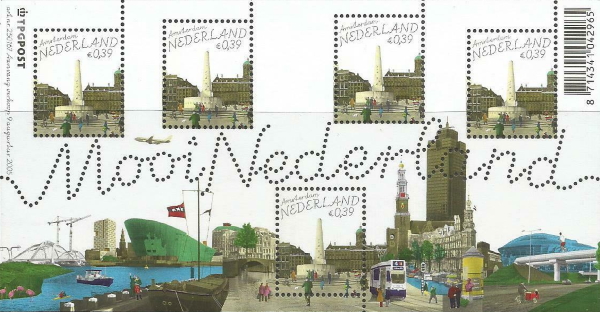 |
|
14-10-2005: Beautiful Netherlands (Mooi Nederland) sheet: 2005 collection I This sheet contains the first 5 stamps of a series of 10, which were issued in sheets (5 x € 0,39) during 2005. This sheet was available from every post office in The Netherlands. The sheet shows two stamps with railway related subjects: Rotterdam with Erasmus Bridge and Amsterdam with De Dam and tram rails. Designer: Esther de Vries print: offset, Joh. Enschedé paper: non-phosphorescent with phosphorescent beam Perforation: 14½:14¼ Watermark: none Glue: ? Value: 5 x 0,39 Euros Circulation: - Catalogue numbers: / Stanley Gibbons / Michel BL91 / Yvert Tellier BF87 / NVPH 2364 + M321 / Scott |
 |
|
14-10-2005: Dutch trains Set of four stamps showing typically Dutch trains, issued in a sheet of 10, on the occasion of the reopening of the Utrecht Railway Museum which was renovated. Above left you see the "blauwe engel" (Blue Angel). Plan X, earlier: stock DE1 and DE2, better known under the name Blauwe Engel, was a series of Dutch diesel-electric trainsets. The name was derived from the bright blue colour that these trainsets initially had. A connection with the famous film Der blaue Engel, featuring Marlène Dietrich from 1929 has often been suggested, but never established. This rolling stock was built in 1953-1954 by the Rotterdam rolling stock manufacturer Allan (in full: Allan & Co's Koninklijke Nederlandsche Fabrieken van Meubelen en Spoorwegmaterieel NV) on behalf of the Dutch Railways. 30 motor coaches DE1 (numbered 21-50) and 46 two-piece train sets DE2 (numbered 61-106) were built. A DE1 had only two compartments: smoking and no smoking. There was no separate 1st class compartment, instead eight seats in the non-smoking compartment had different seat covers and these were considered 1st class. The whole series was built under the name Plan X, but this name was only really used for the sets that were modernized in 1975 and painted yellow. They also received new numbers: 161-186. The Blue Angels have not been in service since 2002, but several copies have been preserved. This train is now to be seen in the Utrecht railway museum. Its official name is DE 41 and it was introduced in 1953. It could contain 73 passengers. Above right you see steam locomotive 3737. It ran services till 1957. One still survives and is operational. It sometimes carries out special rides. The class NS 3700 was a series of express steam locomotives with the 2'C axle layout of the Dutch Railways (NS) and its predecessor Maatschappij tot Exploitatie van Staatsspoorwegen (SS). The first 109 locomotives of this series were delivered to the SS in the years 1910 to 1920 and numbered 685 - 778 and 785 - 799. The manufacturers were Beyer, Peacock and Company (36 units), Werkspoor (48 units), Hanomag (10 units). pieces) and Henschel & Sohn (15 pieces). After the merger of the SS and HSM equipment park in 1921, 6 more machines were delivered by Werkspoor that same year. The series was then given the NS numbers 3701-3815. In 1928 an additional order of 5 slightly different Schwarzkopff locomotives was added. The entire number series then became 3701-3820. Locomotive 3737, the original SS 731, built by Werkspoor in 1911, made its first test drive between Amsterdam and Utrecht on 28 August 1911. She was officially commissioned on September 11, 1911. Locomotive 3737 (from the Roosendaal depot) ran the last official NS steam train from Geldermalsen to Utrecht Maliebaan station, where the Dutch Railway Museum was already located on 7 January 1958. The 3737 locomotive was subsequently included in the museum's collection. In the 1970s, the NS 3737 was made ready to drive again to be used for special journeys. In the 1974 and '75 seasons, the locomotive was leased to Stichting Stoomtrein Tilburg-Turnhout (SSTT), which operated a tourist train service on part of the Tilburg - Turnhout railway line. The 3737 played an important role in the anniversary celebration of 150 years of Railways in the Netherlands in 1989. In the years that followed, the locomotive, home to the Railway Museum, was occasionally active on the railway network. In 1996 she got a completely new boiler with a new firebox. The intention was to use the locomotive on a regular basis, but it broke down after just a few runs. When proper repairs were needed in 2008, the Railway Museum announced that it wanted to use part of a subsidy received from the BankGiro Loterij for this purpose, but at the end of 2008 the amount turned out to be insufficient. On the left again you see an Intercity Express train. It is a German ICE train which can reach speeds up to 330 kilometers per hour on special high speed track, not available in Holland at the moment that these stamps were issued. The Intercity Express, abbreviated as ICE, is the fastest train operated by the railway company DB Fernverkehr, part of Deutsche Bahn AG. It is also the highest train category. The high-speed trains are built by Siemens. Since 1985, the Deutsche Bundesbahn has been experimenting with its own high-speed train, as a counterpart to the Japanese Shinkansen and the French TGV. The motor cars of the prototype ICE-V (formerly Intercity Experimental) were delivered to the DB in March 1985. The intermediate cars followed: on July 31, 1985 they were delivered in Donauwörth. The ICE-V was presented to the public on November 26, 1985. On the same day, the fully loaded ICE reached a speed of 317 km / h on the route from Gütersloh to Hamm at 11:29 am. After several other test drives, this ICE reached a speed of 406.9 km/h on May 1, 1988. The ICE 3M (BR 406) has been developed to be able to operate on the railways outside Germany, which is suitable for the four most common catenary voltages and train control systems in Europe. The DB uses 13 trainsets and the Dutch Railways 3, which are used for the connections Brussels - Liège - Cologne - Frankfurt and Amsterdam - Cologne - Frankfurt - Mannheim - Freiburg - Basel SBB. Since December 10, 2006, there has been a direct ICE connection from Amsterdam via Frankfurt (Main) Hauptbahnhof to Munich for a year. From the Netherlands it is now possible to travel to Frankfurt am Main with ICE seven times a day. Last but not least you see the Front Runner (Koploper), which has been in use since 1977. The train driver is high above the passenger compartment, which makes it possible to couple carriages without obstructing the way through to the next carriage. It was also the first train in which benches were not only placed opposite each other but behind each other as well. It is officially called ICM. Intercity stock (ICM) is a train set of NS Passengers that is mainly used in intercity train services. The rolling stock name is Plan Z. The train, designed by the design agency of designer Raymond Loewy, was nicknamed Koploper, because of the so-called walk-through head. The trainset owes its official nickname to its characteristic run-through head. This construction, devised by prof. Ir. N.H.C.E. Zeevenhooven, made it possible for travellers, catering staff and conductors to change trains during the journey. Travellers could change trains if they had boarded in the wrong part or because the trainset where they had boarded was too full. Travellers without valid tickets no longer had the opportunity to avoid the conductor in these trains, whereas with other coupled trains this is relatively easy by selecting the train set without a conductor just before departure. After the modernization of the trains, this walk-through head was removed. The overhauled trains are also called Intercity rolling stock modern (ICMm for short). The first trainsets entered service in 1977. The trains built between 1983 and 1994 still run daily on the Dutch railway network and, together with the VIRM, form the most important material on the connections from the Randstad with the rest of the country. [source: wikipedia] The Collect Club of Dutch postal services issues a magazine called Collect. Collect 2005-45 dealt with these stamps. (article in Dutch) Designers: Kummer & Herrman print: offset, Joh. Enschedé paper: non-phosphorescent with phosphorescent beam Perforation: 14½ Watermark: none Glue: ? Value: 10 x 0,39 Euros Circulation: 360.000 sheets Catalogue numbers: / Stanley Gibbons 2474-2477 / Michel 2338-2341 / Yvert Tellier 2262-2265 / NVPH 2366-2369 / Scott |
 |
|
02-01-2006: Dutch train rushing past. A series of 5 stamps for delivery outside Europe shows Dutch cultural heritage. One of them shows a train rushing past. It is a work of art made in 2003 by a young American artist named Sean Snyder. It is called "Boerderijgezichten": farm views. The stamp shows the infrastructure of motorways and railways which provide mobility for the always busy Dutchmen. Designer: Werkplaats Typography: Jeff Ramsey print: Walsall Security Printers, Walsall, England paper: gravure; not phosphorescent with phosphorescent beam Perforation: punched Watermark: none Glue: self-adhesive Value: 0,85 Euros Circulation: 900,000 sheets Catalogue numbers: / Stanley Gibbons 2517 / Michel 2387 / Yvert Tellier 2311 / NVPH 2410 / Scott |
 |
|
02-01-2006: Lost Luggage Depot in Rotterdam Lost Luggage Depot is an artwork by Canadian artist Jeff Wall. It is situated in Rotterdam and was established in 2001. Although this artwork has a connection with the Holland-America Line, lost luggage depots are also a common aspect of everyday rail travel. The work comprises an octagonal framework with three levels. All its components, apart from the lamp post in the middle, are casts of existing objects, from the suitcases, bags, boxes and kit bags through the beams and planks of the framework to the depot manager’s coffee mugs, cooking ring and flattened Coke cans in the bin. The result of this unconventionally executed material duplication recalls the freezing of a moment in time as captured in photography. The objects in the depot are from various periods in time, ranging from a century-old duffel bag to a very recent computer holdall. At the moment the iron founder finished the work, the accumulation of time inferred came to a standstill and the history represented was concluded. Wall chose cast-iron instead of bronze for its rougher quality and the fact that cast-iron puts a slightly greater distance between the objects and their original materials. The sculpture has a seven-degree rotation so that the lower and upper levels of the framework jump out from each other thereby creating a subtle broken rhythm. This can be seen as symbolically representing the historical split between an original object and its reproduction – this broken link, however, is still a link. As the artist explains: “When you enter it [the work] you will know that it is not real. Yet, because it has been cast from real things, it will appear to present a direct trace of those things, things that must have existed if their casts were to have been taken.” By painting everything in a matt rust-colour, Wall not only increases the formal unity of the piece as a whole, but highlights the historical disruption lurking behind the apparently literal appearance of the casts." Designer: Werkplaats print: Walsall Security Printers, Walsall, England paper: gravure; not phosphorescent with phosphorescent beam Perforation: punched Watermark: none Glue: self-adhesive Value: 0,69 Euros Circulation: 1,000,000 sheets Catalogue numbers: / Stanley Gibbons 2511 / Michel 2381 / Yvert Tellier 2305 / NVPH 2404 / Scott |
 |
|
11-12-2006: Railway bridge "De Hef". In a sheet of 10 showing Dutch products we encounter one stamp with a railway bridge, the so-called Hef (vertical lift-bridge) near Rotterdam. The official name is King's harbour bridge (Koningshavenbrug). The bridge was designed by P. Joosting and operational since 31 October 1927. Before that time the bridge was a swivel-bridge. The raised bridge is visible in the background on the right. Most of the time this bridge was raised to allow ships to pass. It is no longer in use. Designer: ...,staat print: Walsall Security Printers, Walsall, England paper: offset Perforation: punched Watermark: none Glue: self-adhesive Value: 0,44 Euros Circulation: 3,300,000 sheets Catalogue numbers: / Stanley Gibbons 2567 / Michel 2463 / Yvert Tellier 2395 / NVPH 2470 / Scott |
 |
|
15-08-2007: Beautiful Netherlands (Mooi Nederland) sheet: The Hague Here we see how two tramtracks of Randstadrail in The Hague cross. These double and separated tracks are on enormous concrete pillars high above broad streets as Prinses Beatrixlaan and Schenkkade. The orange coloured tram of the HTM (Haagse Tramweg Maatschappij - The Hague Tram Company) is number 17 driving to Statenkwartier. At the right of the tram you can see some passengers. This sheet was only available in The Hague and the TNT Post website (Collect Club). The Hague tram has been operated by HTM Personenvervoer N.V. since 2002. The track gauge is standard gauge (1435 millimeters), the catenary voltage is 600 volts DC and the network is suitable for one-way trams, with reverse loops at the end points. The lines on which the RegioCitadis and the Avenio run are suitable for two-way trams; these lines also have head end points in addition to turning loops. On June 25, 1864, the first tram line in the Netherlands, a horse tram, was opened in The Hague on the route Den Haag Parkstraat - (Oude Scheveningseweg) - Scheveningen Kurhaus. In the years that followed, this line was followed in the Hague region by seven others. The horse tram was maintained until the beginning of the 20th century, when a significant modernization could be realized through electrification of the tram network. The last horse tram in The Hague ran on March 4, 1907. On July 1, 1879, the first steam tram line in the Netherlands was opened in The Hague on the line Rhijnspoorstation - (Koningskade) - Scheveningen. This line was followed by four others in the following years. The lines fell outside the horse tram concession of the Société Anonyme des Tramways de La Haye, therefore had different operators and were intended to compete with the existing horse tram network (the exception to this was the horse tram line The Hague - Delft, which has always been owned of the HTM and its legal predecessors). The steam tram lines partly determined the image of local rail transport in The Hague for more than 40 years. The last steam tram in The Hague (of the WSM) ran on October 1, 1932. On August 2, 1890 the first electric tram started operating - albeit briefly - in the Netherlands. It was a battery tram on the Plein - (Nieuwe Parklaan) - Scheveningen route. A year later it was officially in service. In 1904 The Hague decided to electrify the HTM tram network using overhead wires. The lines were also numbered: the old horse tram lines were given line numbers 1 to 4, the former battery tram was given line number 9 and the other line to Scheveningen was given line number 8. New lines were set up with line numbers 5 to 7 and 10. Al these lines were so-called concession lines, and were an elaboration of the Tramplan 1904. Three non-concession lines - also known as HTM's own lines - were established with line numbers 12 to 14, of which line 13 was a continuation of a former horse tram line. Line number 11 was administratively assigned to the HTM steam tram line to Delft; however, when this line was electrified in 1923/1924, it was given the line number I¹, so that number 11 was released again. The successor to the steam tram line from HIJSM to Scheveningen was assigned this number in 1927 after the HTM took over the route and electrification. From 1912, new lines were added to the network, which were given line numbers 15 and higher. The concession remained in effect until December 31, 1926. On August 6, 1904: Line 9 was the first electric tram in The Hague with overhead wires installed on the Plein - Scheveningen Kurhaus route. The accutram used to run here. Effective January 1, 1927, the N.V. Mixed Company Haagsche Tramweg-Maatschappij was established with which the municipality of The Hague, by owning 4 of the 6 shares, was in control of the development of public transport in the city. The new society faced many challenges. For example, the population of The Hague had almost doubled and lines to the new suburbs had to be planned and built. An investment in new equipment was also required, the last new motor cars were from the 290-299 sub-series. Private bus transport had to be tackled as it picked up many passengers from the tram. On the said date, HTM started operating a number of bus lines that would function as a supply line for the tram lines to be extended. In addition to the city tram network, there were three other 'outside lines' operated by HTM that crossed municipal boundaries: the lines from The Hague to Rijswijk - Delft (line I'), Wassenaar - Leiden (line I²) and Rijswijk - Voorburg (line I³). [source: wikipedia] Designer: Jeen Berting print: offset, Joh. Enschedé paper: non-phosphorescent with phosphorescent beam Perforation: 14½:14¼ Watermark: none Glue: ? Value: 5 x 0,44 Euros Circulation: 159,000 sheets Catalogue numbers: / Stanley Gibbons 2601 / Michel 2515KB / Yvert Tellier 2439 / NVPH 2517 / Scott |
 |
|
03-10-2007: Beautiful Netherlands (Mooi Nederland) sheet: Utrecht Utrecht is Holland's main railway junction as you can see from the diverging railway tracks and the railway bridge with vertical red-and-white railway barrier. The stamp itself shows the administrative building III of the Dutch Railways (NS), nicknamed The Inkwell. This sheet was only available in Utrecht and the TNT Post website (Collect Club). The Inkwell is the largest brick building in the Netherlands, designed by George van Heukelom on behalf of the partnership interest Netherlands Railways (NS). The national monument is located at Moreelsepark in Utrecht near Utrecht Central Station and is now used as the head office of ProRail. The Inkwell was built between 1918 and 1921, from 1919 under the construction management of George van Heukelom. Originally the building was called Hoofdadministregebouw III (hgb III), but since the building has not been used by NS since 1995, but by ProRail, the form-based nickname The Inkwell has been the official name. The structure was placed next to two older main buildings of the railway company. The Nieuweroord country estate with surrounding public park served as building land. The Inkwell was built with 22 million masonry bricks. Due to the scarcity after the First World War, the construction was taken over by the NS. Two brick factories, a timber company and three ships were purchased. Since 4000 cubic meters of oak was needed, a Limburg forest was also purchased. Due to the scarcity of building materials, 21 kilometers of old rails were used for the foundation of the building. Jan Schouten provided the stained glass for the building. Also located in The Inkwell is a water tower with a reservoir of 27 cubic meters, built in 1921 and also designed by Van Heukelom. The small park located in front of the building with walls of sintered stone, among other things, is also his design; his furniture designed for the building was discarded and destroyed in the 1970s. Only tables and chairs from the Commissioners' Hall survived because they were handed over by the Dutch Railways to the Cultural Heritage Agency of the Netherlands in 1983. Some were on loan from 2015 to 2020 from the CDA faction in the Senate, and were requested back on loan at the request of ProRail. For example, the Catharijnezaal, as the Commissioners' Hall is now called, was restored to its former glory in 2020. [source: wikipedia] Designer: Jeen Berting print: offset, Joh. Enschedé paper: non-phosphorescent with phosphorescent beam Perforation: 14½:14¼ Watermark: none Glue: ? Value: 5 x 0,44 Euros Circulation: 144,000 sheets Catalogue numbers: / Stanley Gibbons / Michel 2521KB / Yvert Tellier 2445 / NVPH 2523 / Scott |
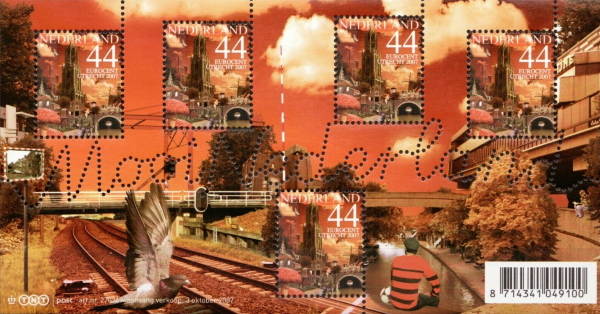  |
|
17-10-2007: Beautiful Netherlands (Mooi Nederland) sheet: 2007 Collection I Apart from the Utrecht stamp, you can see a bridge behind the Gouda stamp. Designer: Jeen Berting print: offset, Joh. Enschedé paper: non-phosphorescent with phosphorescent beam Perforation: 14½:14¼ Watermark: none Glue: ? Value: 5 x 0,44 Euros Circulation: 438,500 sheets Catalogue numbers: / Stanley Gibbons / Michel BL106 / Yvert Tellier 93 / NVPH 2525 + M363 / Scott |
 |
|
25-03-2008: Beautiful Netherlands (Mooi Nederland) sheet: Sneek This sheet has a prominent place for the old Sneek railway station (lower left hand corner). This station was built in 1883 and serves the line Stavoren- Leeuwarden. Since 2004 the National Model Railway Museum is housed in the building. This sheet was only available in Sneek and the TNT Post website (Collect Club). The Model Railway Museum is housed in the station of Sneek. The station was built in 1883 and is of the type “Third State Building type 2” in neo-renaissance style, characterized by the natural stone horizontal bands and ornaments above the windows. Stations of the same type were also built in Tiel, Gorinchem, Appingedam, Delfzijl and Workum. The design is by Rijkswaterstaat. The contractor was B.H. Trooster from Zwolle, which, however, went bankrupt in the course of 1883, so that the station building was not yet ready when the Leeuwarden-Sneek railway line was opened. The station was officially opened on May 20, 1884 without any festivities. From May 1999 NoordNed took over the operation of the northern lines from the Dutch Railways. The station restoration was closed. The board of the Model railway museum then came up with the idea to accommodate the museum in it. In 2004 the building was completely restored and, on the outside as much as possible in its original state, by NS Vastgoed. Architect Harmen Grunstra from Bolsward designed the interior with a floating intermediate floor to reveal the special roof construction that appeared during the renovation. [source: national model railway museum, Sneek] Designer: 178 aardige ontwerpers, Amsterdam print: offset, Joh. Enschedé paper: non-phosphorescent with phosphorescent beam Perforation: 14½:14¼ Watermark: none Glue: ? Value: 5 x 0,44 Euros Circulation: 109,500 sheets Catalogue numbers: / Stanley Gibbons / Michel 2567KB / Yvert Tellier 95 / NVPH 2565 / Scott |
 |
|
28-04-2009: Beautiful Netherlands (Mooi Nederland) sheet: Roosendaal Several railway related elements play a part in this sheet. First of all the fact that Roosendaal is an important junction of railway lines and the gateway to the countries south of The Netherlands.   Furthermore you can find Roosendaal station in this sheet, at least the conspicuous window design: 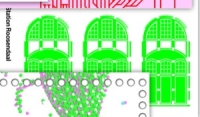 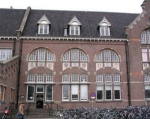
This sheet was only available in Roosendaal and the TNT Post website (Collect Club). Due to its location on the railway line (Amsterdam -) Rotterdam - Antwerp (- Brussels - Paris), Roosendaal fulfilled an important international logistics function. Roosendaal is the last station on Dutch territory before the border with Belgium. The intercity Amsterdam - Brussels stopped here. Since the beginning of April 2018, this train has been running over the HSL South, via Breda, which already fulfills an important border function for car traffic (A16 / E19). In 1854 a Belgian company built a railway from Antwerp via Roosendaal to Moerdijk, including a branch from Roosendaal to Moerdijk. This meant an impulse for the development of the village of Roosendaal. Connections with Rotterdam (1877), Vlissingen (1872) turned Roosendaal station into a real railway junction. Forwarding agents soon established themselves near the border station. To accommodate the growth of international passenger and freight transport, a new and much larger station complex was put into use in 1907. [source: wikipedia] Designer: Silo Grafisch Ontwerpbureau (Silo graphic designers), 's-Gravenhage (The Hague) print: offset, Joh. Enschedé paper: non-phosphorescent with phosphorescent beam Perforation: 14½:14¼ Watermark: none Glue: ? Value: 5 x 0,44 Euros Circulation: 110,000 sheets Catalogue numbers: / Stanley Gibbons 2713 / Michel 2659KB / Yvert Tellier BF99 / NVPH 2644 / Scott |
 |
|
28-04-2009: Beautiful Netherlands (Mooi Nederland) sheet: Oosterhout At first sight this sheet doesn't contain any railway related images at all, but appearances are deceptive. There is one item connected with railways: the Burgundian duo.  They represent the two delegates who went to The Hague to plead for a railway station in Oosterhout. As the story goes they chose to go and have a good meal first. This caused them to be late for the meeting. In the meantime it had been decided that the railway station would be built in a neighbouring village called Rijen. This must have been in 1862 or thereabouts, as the line Breda - Tilburg opened in 1863. The Rijen sation is still operational. This sheet was only available in Oosterhout and the TNT Post website (Collect Club). Designer: Silo Grafisch Ontwerpbureau (Silo graphic designers), 's-Gravenhage (The Hague) print: offset, Joh. Enschedé paper: non-phosphorescent with phosphorescent beam Perforation: 14½:14¼ Watermark: none Glue: ? Value: 5 x 0,44 Euros Circulation: 110,000 sheets Catalogue numbers: / Stanley Gibbons 2714 / Michel 2660KB / Yvert Tellier 2587 / NVPH 2643 / Scott |
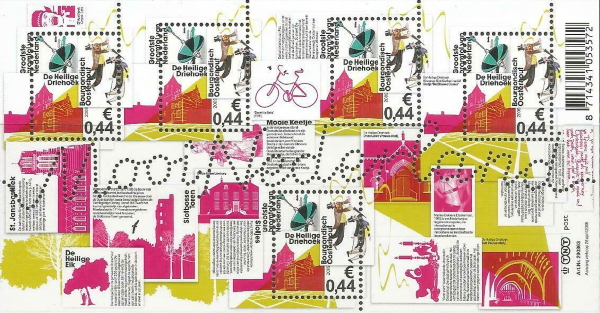 |
|
16-06-2009: Beautiful Netherlands (Mooi Nederland) sheet: the 2009 collection Both the Roosendaal and Oosterhout sheets of this year are included in this 2009 collection sheet Designer: Silo Grafisch Ontwerpbureau (Silo graphic designers), 's-Gravenhage (The Hague) print: offset, Joh. Enschedé paper: non-phosphorescent with phosphorescent beam Perforation: 14½:14¼ Watermark: none Glue: ? Value: 5 x 0,44 Euros Circulation: 450,000 sheets Catalogue numbers: / Stanley Gibbons MS2722 / Michel BL118 / Yvert Tellier / NVPH 2651 + M396 / Scott |
 |
|
23-03-2010: 75 years of theme park Duinrell in Wassenaar This stamp shows the roller coaster at Duinerell theme park. You could consider a roller coaster as a special type of rail transport. The frog roller coaster is a steel roller coaster and one of Duinrell's first attractions. The frog roller coaster was built by the German attraction builder Zierer and opened in 1985. The capacity of the frog roller coaster is approximately 1250 people per hour. Children from a height of 1 meter 20 are allowed in the attraction unaccompanied. Smaller children only if accompanied by an adult. Its train consists of 20 cars with two seats next to each other, which amounts to a maximum of 40 people per ride. The passenger safety lock is a so-called lap bar. The train is blue in colour. On the sides of the carts are surfaces, which have a different colour (red, green or yellow) for each cart. All seats are black in every cart. On the nose of the front carriage of the train, Rick the Frog is depicted with his hands folded and his chin resting on it. Designer: Smidswater Office print: gravure, De la Rue, Byfleet, England Perforation: perforation combination 14½:14½ Watermark: none Glue: ? Value: 0,44 Euros Circulation: 410,000 sheets Catalogue numbers: / Stanley Gibbons 2766 / Michel 2739 / Yvert Tellier 2667 / NVPH 2710 / Scott |
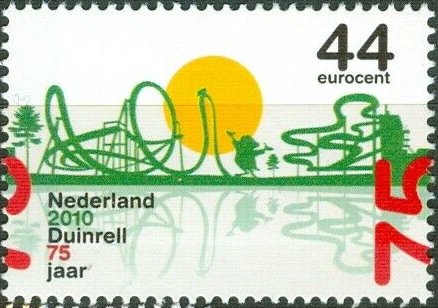 |
|
29-03-2010: Beautiful Netherlands (Mooi Nederland) sheet: Maastricht The sheet shows St. Servaas Bridge, which carried tram lines from 1896 till the end of World War I. St. Servaas Bridge has been discussed above. Designer: Sun Jung Hwang print: offset, Joh. Enschedé paper: non-phosphorescent with phosphorescent beam Perforation: 14½:14¼ Watermark: none Glue: ? Value: 5 x 0,44 Euros Circulation: 97,000 sheets Catalogue numbers: / Stanley Gibbons 2770 / Michel 2742KB / Yvert Tellier 2671 / NVPH 2715 / Scott |
 |
|
10-01-2011: Beautiful Netherlands (Mooi Nederland) sheet: Almere A small passenger train is to be seen in between the third and fourth stamps. Designer: Huug Schipper, Studio Tint (The Hague) print: offset, Joh. Enschedé paper: non-phosphorescent with phosphorescent beam Size stamps: 20,8 x 25,3 mm Perforation: 14½:14¼ Watermark: none Glue: synthetic Value: 5 x 1 (for letters up to 20 grammes) (=0.48 euros) Circulation: ? sheets Catalogue numbers: / Stanley Gibbons 2821 / Michel 2827KB / Yvert Tellier 2755 / NVPH 2789 / Scott |
 
|
|
23-05-2011: Beautiful Netherlands (Mooi Nederland) sheet: the 2011 collection Above the Enschede stamp is a small train. Designer: Huug Schipper, Studio Tint (The Hague) print: offset, Joh. Enschedé paper: non-phosphorescent with phosphorescent beam Size stamps: 20,8 x 25,3 mm Perforation: 14½:14¼ Watermark: none Glue: synthetic Value: 5 x 1 (for letters up to 20 grammes) (=0.46 euros) Circulation: 490,000 sheets Catalogue numbers: / Stanley Gibbons / Michel 2869 + sheet 134/ Yvert Tellier BF102 / NVPH 2822 + M436 / Scott |
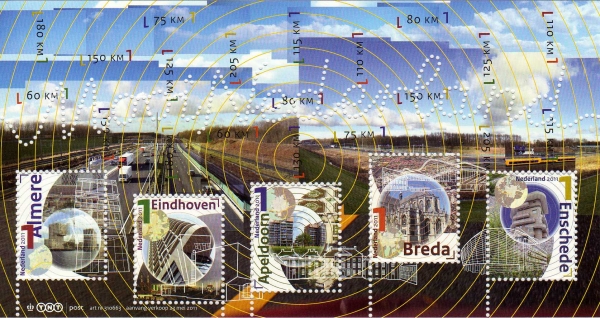 
|
|
22-08-2011: One hundred years "Heemschut" Heemschut is a sort of National Trust that protects our cultural heritage. It is a private association though. One of the buildings that was protected from demolition in 1972 is the Amsterdam "Noord-Zuid-Hollands koffiehuis", a café in Station Square by architect J.H.W. Leliman, one of the founders of "Heemschut". It was rebuilt in 1980 in front of Amsterdam Central Station, which is in the background. The café is in the fourth and ninth stamps in the sheet. Furthermore there is the St.-Servaas bridge in Maastricht in the fifth stamp. This bridge carried a streetcar until 1914. The Dutch postal service issued an information leaflet on the subject in Dutch. It is here (opens in a new tab or window). Designers: Piet Gerards and Maud van Rossum print: offset, Lowe-Martin Group, Canada paper: non-phosphorescent with phosphorescent overprint Size stamps: 36 x 25 mm Perforation: 13:13 Watermark: none Glue: synthetic Value: 10 x 1 (for letters up to 20 grammes) (=0.48 euros) Circulation: 282,000 sheets Catalogue numbers: / Stanley Gibbons 2883 + 2884/ Michel 2890 + 2891 / Yvert Tellier 2818 + 2819 / NVPH 2852 + 2854 on M440 / Scott |
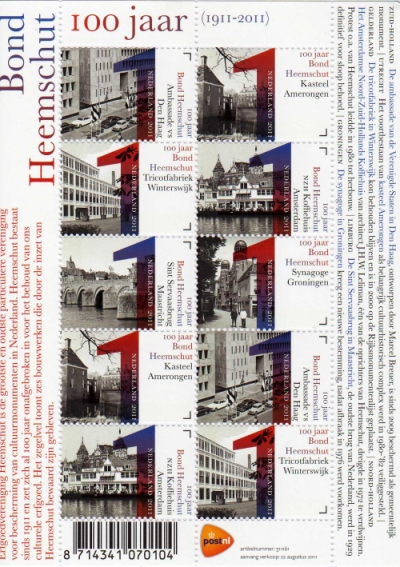   |
|
01-09-2011: "Green mail" These stamps originate from a sheet of 10 stamps for national use. All ten stamps have an environmental subject, two of which are related with the train. The stamp on top shows a suitcase with the text: "travel consciously, let the environment relax" (in Dutch: Bewust reizen. Laat het milieu ontspannen). And of course we all know that taking the train is a very environment-friendly way of travelling. The other stamp shows a bus, but the text also applies to rail travel: "Go forward fast with electric transport" (in Dutch: Snel vooruit met elektrisch vervoer). Most railway lines in The Netherlands are electrified, so this text is also appropriate for the railways. Designers: Gesina Roters print: offset, Walsall security printers, England paper: non-phosphorescent with phosphorescent overprint Size stamps: 20,8 x 25,3 mm Perforation: slit Watermark: none Glue: synthetic, self-adhesive Value: 10 x 1 (for letters up to 20 grammes) (=0.48 euros) Circulation: ? sheets Catalogue numbers: / Stanley Gibbons 2893 + 2895 / Michel 2900 + 2902 / Yvert Tellier 2828 + 2830 / NVPH 2863 + 2865 on M441 / Scott |
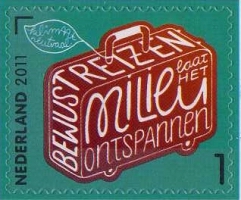   |
|
18-06-2012: The Netherlands in the Bos Atlas The Bos Atlas was the first atlas for educational purposes in The Netherlands and it still exists. The atlas is published by Wolters-Noordhoff Publishers in Groningen. Simultaneously with the issue of the stamp sheet the 54th edition of the atlas appeared. The first edition was made by the Groningen headmaster P.R.Bos and appeared in 1877. The top left stamp shows the first edition and some railway lines are on it. In fact several stamps show railway lines. That is why this sheet is mentioned here. The Dutch postal service issued an information leaflet on the subject in Dutch. It is here (opens in a new tab or window). Designers: studio Haller Brun (Sonja Haller and Pascal Brun), Amsterdam print: offset, Joh. Enschedé Security Print, Haarlem paper: non-phosphorescent with phosphorescent overprint Size stamps: 36 x 25 mm Perforation: 14½ : 14½ Watermark: none Glue: synthetic Value: 10 x 1 (for letters up to 20 grammes) (=0.50 euros) Circulation: 240,000 sheets Catalogue numbers: / Stanley Gibbons MS2959 / Michel 2980-2989 / Yvert Tellier 2907-2916 / NVPH 2937-2946 on M460 / Scott |
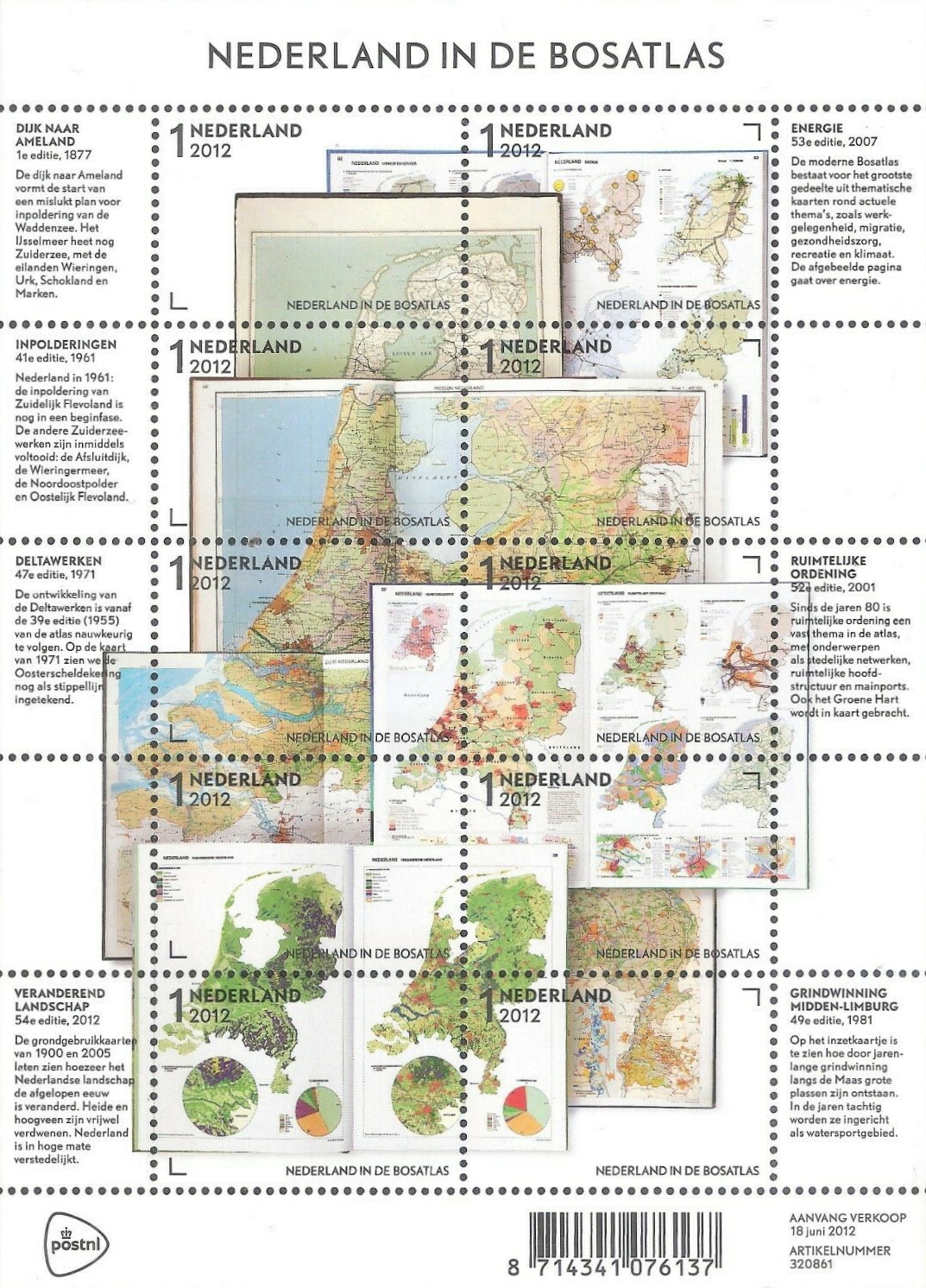 |
|
28-01-2013: 125th anniversary of ARCADIS (and KNHM) Arcadis designed the ecoduct (ecological viaduct) at Zanderij Crailoo near Hilversum. The ecoduct measures 800 metres and is one of the longest in its kind. It spans four obstacles, among which a very busy provincial throughroad and a railway line. This bridge connects two natural areas and it restored the ecological connection between them. The stamp showing a train which passes under the ecoduct can be found in the upper right hand cormer. Another highlight of Arcadis' achievements is Amsterdam Bijlmer ArenA railway station. 60,000 passengers get in and out at this station daily. They enjoy the abundant daylight in the open spaces between the four viaducts. The 29 metres high glass roof seems to float on steel columns. The woodclad roof parts provide this Arcadis designed "Bijlmer cathedral" with a warm atmosphere. The stamp showing the station can be found in the lower left hand corner. Designers: Werf3 (Amsterdam): Nadji van den Broek and René Kuijpers used font: Akkurat (2004) by Laurenz Brunner print: offset by Cartor Security Printing, France paper: non-phosphorescent with phosphorescent overprint Size stamps: 36×25 mm Perforation: 13½:13½ Watermark: none Glue: synthetic Value: 10 x 1 (for letters up to 20 grammes) (=0.54 euros, from januari 2013 onwards)) Circulation: 240,000 sheets Catalogue numbers: / Stanley Gibbons / Michel 3066 + 3076 / Yvert Tellier / NVPH 3017 + 3024 on M473 / Scott |
  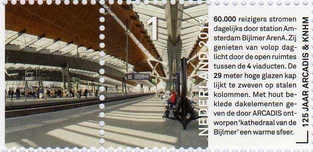 |
|
09-09-2013: The Peace Palace in The Hague is 100 years old The Peace Palace (Dutch: Vredespaleis) in The Hague is the seat of international law because it houses the International Court of Justice. The Palace officially opened on August 28, 1913, and was built for the Permanent Court of Arbitration, created to end war as stated in a treaty at the 1899 Hague Peace Conference. Andrew Dickson White, whose efforts were instrumental in creating this court wrote to his friend Andrew Carnegie, who eventually provided 1.5 million dollars to build the Peace Palace. In the Great Hall there are several stained glass windows, one of which is called Industria. This window contains the image of a steam locomotive. The window was designed by Herman Rosse (1887 – 1965) and manufactured by J.W. Gips.  Designer: Mart Warmerdam, Haarlem used font: Avenir (1988) by Adrian Frutiger print: offset by Joh. Enschedé Security Print, Haarlem paper: non-phosphorescent with phosphorescent overprint Size stamps: 36 x 25 mm Perforation: 14½:14½ Watermark: none Glue: synthetic Value: 10 x 1 (for letters up to 20 grammes) (=0.60 euros, from august 2013 onwards) Circulation: 200.000 sheets Article number: 330862 Catalogue numbers: / Stanley Gibbons 3035 / Michel 3154 / Yvert Tellier 3082 / NVPH 3105 on M487 / Scott |
 |
|
08-09-2014: 175 years of Dutch Railways The sheet contains ten stamps commemorating the 175th birthday of Dutch Railways. Nowadays the railways consist of two companies: NS, responsible for the transportation of passengers and goods, and ProRail, responsible for infrastructure: tracks, stations and the like. The following trains are shown: stamp 1: rail inspection vehicle NS 20, a diesel electric loco called The Camel, from 1954. stamps 1 and 2: NS goods loco series 2200, diesel electric, used from 1955 - 2003. stamp 4: NS 386, an electric passenger train nicknamed Dog's Head, used from 1962-1996. stamp 8: ICM intercity train, used since 1977. stamp 10: SLT, Sprinter Light Train, used since 2009. Other railway related subjects: stamp 2: standard railway station clock. stamp 3: Haarlem Station: the first class waitingroom plaque (this plaque was also used for railway letter stamps) stamp 8: railway clock from Rotterdam Central station and the new Rotterdam Station building. stamps 5 amd 7: Railway signal: stop and go. stamp 5: The Rotterdam "Hef" bridge. stamp 6: Amsterdam Station Flying Wheel logo, designed by the architect P.J.H. Cuijpers, used from 1889 to 1930. stamps 6 also shows a railway ticket. From this year onwards railway tickets are no longer in use. The words Tiener Toer refer to a special ticket for teenagers available during the holiday season. It was valid for several days. stamp 9: The old and new NS logos. The logo below was used from 1946 to 1968. The "fishhook"logo was designed by Dumbar and Van Raalte and is in use from 1968 onwards. stamp 10: the 1939 stamp issued on the occasion of 100 years Dutch railways. The Dutch postal service issued an information leaflet on the subject in Dutch. It is here (opens in a new tab or window). Collect magazine also spent a Dutch article on this subject. You can read it in Collect number 81. Designer: Wout de Vringer, The Hague print: Cartor Security Printing, France paper: non-phosphorescent with phosphorescent overprint Size stamps: 36 x 25 mm Perforation: 14½:14 ½ Watermark: none Glue: synthetic Value: 10 x 1 (for letters up to 20 grammes) (=0.64 euros) Circulation: 179.000 sheets Article number: 341261 Catalogue numbers: / Stanley Gibbons MS3140 / Michel 3272-3281 / Yvert Tellier 3198-3207 / NVPH 3219-3228 / Scott |
 |
|
30-03-2015: Sheet showing Dutch bridges The sheet shows ten Dutch bridges, two of which are railway bridges. In the top left hand corner you can see the Moerdijk railway bridges. There are two beside each other. The one conspicuously in the foreground is the so-called HSL-bridge (HSL hogesnelheidslijn = HST high speed train). The one in the background is the old Moerdijk railway bridge. The three Moerdijkbridges connect the island of Dordrecht in the province of South-Holland with the province of North-Brabant across the Hollandsch Diep waterway. From west to east thre are a road bridge, the two-rail HSL-South bridge, and a two-rail bridge for the line Dordrecht - Lage Zwaluwe. The old railway bridge, which is still in use, was built at the end of the 19th century and was opened in January 1871. In the fifties of the 20th century it was replaced by a newer, wider, version. The conctruction of the HSL-South line made it necessary to build a third Moerdijk bridge. Construction of this "cat's back" was started in 2000 by Benthem Crouwel Architects. The first HST crossed this bridge at 300 kilometres an hour during a test run in 2006. The second railway bridge is shown in the bottom left hand corner. It is the so-called Hanzeboog (Hanze Bow). It spans the river IJssel and is part of the line Utrecht - Kampen and the Lelystad - Zwolle line which was opened in December 2012. This new bridge is high enough for ships to pass under it, so there are no movable parts in this bridge. It is a kilometre in length and rests on 18 concrete pillars. The design is by Quist Wintermans Architects. The bridge was used for the first time in the direction of Amersfoort-Zwolle during the Easter weekend of 2011 and in the direction of Zwolle-Amersfoort during the Pentecost weekend of the same year. [source: wikipedia] The bottom stamp is not about the bridge, but about the backgroud, which shows Amsterdam Central Railway Station. The Dutch postal service issued an information leaflet on the subject in Dutch. It is here (opens in a new tab or window). Designer: Hans and Sabine Bockting print: offset, Joh. Enschedé Security Print, Haarlem paper: phosphorescent overprint Size stamps: 36 x 25 mm Perforation: 14 ½ : 14 ½ Watermark: none Glue: synthetic gum Value: 10 x 1 (for letters up to 20 grammes) (=0.69 euros) Circulation: 190.000 sheets Article number: 351161 Catalogue numbers: / Stanley Gibbons / Michel 3332 + 3336 + 3340 / Yvert Tellier 3258 + 3262 + 3266 / NVPH 3275 + 3279 + 3283 / Scott |
    |
|
28-04-2015: Naardermeer Naardermeer was the first area of natural beauty that was bought by the foundation for Natural monuments (Dutch: Natuurmonumenten) in 1906 and thus became the first nature reserve in the Netherlands. Part of a sheet of 10 are two stamps with a railway related subject. In 1874 the Eastern Railway (Oosterspoorweg) between Amsterdam and Amersfoort was realised. This railway line crosses the Naardermeer lake from west to east. In 1987 the Flevolijn came into use. This line runs along the northern border of the area. The connection between Oosterspoorweg and Flevolijn was constructed with dive-unders instead of fly-overs. The train you see here is a so-called Koploper, Plan Z. Designer: Reynoud Homan print: offset, Joh. Enschedé Security Print, Haarlem paper: phosphorescent overprint Size stamps: 36 x 25 mm Perforation: 14 ½ : 14 ½ Watermark: none Glue: synthetic Value: 10 x 1 (for letters up to 20 grammes) (=0.69 euros) Circulation: 190.000 sheets Article number: 350661 Catalogue numbers: / Stanley Gibbons 3190 - 3191 / Michel 3344 - 3345 / Yvert Tellier 3270 - 3271 / NVPH 3291 - 3292 / Scott |
 |
|
14-09-2015: The Borderless Netherlands: USA connection As New York used to be a Dutch city called New Amsterdam before it was "sold" to the English. New Amsterdam (Dutch: Nieuw-Amsterdam) was a 17th-century Dutch settlement established at the southern tip of Manhattan Island, which served as the seat of the colonial government in New Netherland territory. The trading post became a settlement outside of Fort Amsterdam on Manhattan Island in the New Netherland in 1614. Situated on the strategic, fortifiable southern tip of the island of Manhattan, the fort was meant to defend the Dutch West India Company's fur trade operations in the North River (Hudson River). It became a provincial extension of the Dutch Republic as of 1624 and was designated the capital of the province in 1625. New Amsterdam was renamed New York on September 8, 1664, in honor of the then Duke of York (later James II of England), in whose name the English had captured it. In 1667 the Dutch gave up their claim to the town and the rest of the colony, in exchange for control of the Spice Islands. In 1667 the Treaty of Breda ended the conflict. The Dutch did not press their claims on New Netherland. In return, they were granted the tiny Island of Run in North Maluku, rich in nutmegs, and a guarantee for their de facto possession of Suriname, captured by them that year. [source: Wikipedia] For more than half a century Dutch was the lingua franca of New Amsterdam and New Netherlands. A number of names still remind us of the Dutch presence in New York: Harlem (Haarlem), Brooklyn (Breukelen), Wall Street (Walstraat). The names Haarlem & Breukelen (see stamp 1) are fictitious roadsigns for the New York metro and refer to Harlem and Brooklyn. The second stamp shows The Hague town hall with visible catenary for the streetcars. This town hall was designed by American architect Richard Meier. The New York park High Line (2,3 kms long) is built on the elevated railway of Manhattan which is no longer in use. (stamp 3). Designers: Ryan Pescatore Frisk & Catelijne van Middelkoop print: offset, Cartor Security Printing, La Loupe, France paper: phosphorescent overprint Size stamps: 36 x 25 mm Perforation: 13 1/3 : 13 2/3 Watermark: none Glue: synthetic Value: 6 x 1 (for letters up to 20 grammes) (=1.15 euros) Circulation: 140,000 sheets pop culture, 16,000 sheets language and 16,000 sheets architecture (the three sheets contain the same stamps) Article number: 351364 (A,B,C) Catalogue numbers: / Stanley Gibbons / Michel 3392 + 3393 + 3394 / Yvert Tellier 3318 + 3319 + 3320 / NVPH 3326 + 3327 + 3328 / Scott |
   |
|
02-11-2015: Children's stamps At the top of the sheet, a bit to the right of the middle upper rim, you see a yellow toy locomotive. Furthermore there is a toy train in the stamp in the top right hand corner. The sheet itself is about the Golden Booklets, a series of popular children's books that have been published for sixty odd years now. Designer: Julius Vermeulen print: offset, Cartor Security Printing, La Loupe, France paper: normal with phosphor tagging Size stamps: 36 x 25 mm Perforation: 14 ½ : 14 ½ Watermark: none Glue: synthetic Value: 6 x 1 (+ 0.34)(for letters up to 20 grammes) (1 = 1.15 euros) Circulation: 3.770.000 sheets Article number: 351560 Catalogue numbers: / Stanley Gibbons MS3242 / Michel B162 and 3418-3423 / Yvert Tellier 3344-3349 / NVPH 3362 / Scott |
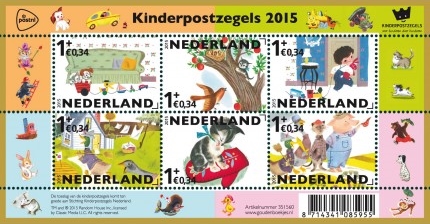 |
|
23-05-2016: Beautiful Netherlands (Mooi Nederland) sheet: Arnemuiden. In the left hand bottom corner of this sheet you can see the Arnemuiden station building. Arnemuiden is a railway station in Arnemuiden in the province of Zeeland. The station was opened on 1 March 1872 and is on the Roosendaal–Vlissingen railway. The station is operated by Nederlandse Spoorwegen. When built, the station was on the northern side of the village. The village has now grown further north so the station is now in the centre. Arnemuiden was basically furnished and consisted only of a station and a small goods shed. In 1877 the yard was extended with a freight siding. The cargo consisted mainly of outgoing fish, shrimp and sugar beet, and receiving coal and food. Until the 1960s, little changed in the yard. In the sixties the sidings gradually fell into disuse. In 1969 they were decommissioned. Since the end of the 1970s, the village has also expanded to the other side of the railway. As with many small stations on the Zeeland Line, the two platforms do not lie opposite each other, but are on either side of a level crossing. In early 2006 NS announced it wanted to remove Arnemuiden, Kapelle-Biezelinge and Krabbendijke from the 2007 timetable. After protests a joint agreement was made for a completely new timetable for Zeeland, calling twice an hour from all stations on the Zeeland line. [source: wikipedia] Designer: Birza Design, Deventer print: offset, Joh. Enschedé Security Print, Haarlem paper: normal with phosphor tagging Size stamps: 20,8 x 25,3 mm Perforation: 14 ½ : 14 ½ Watermark: none Glue: synthetic Value: 5 x 1 Circulation: 60.000 sheets Article number: 360661 Catalogue numbers: / Stanley Gibbons 3281 / Michel 3469KB / Yvert Tellier 3407 / NVPH 3412 / Scott |
 |
|
23-05-2016 (2): Beautiful Netherlands (Mooi Nederland) survey sheet: Arnemuiden Station Building Again the same Arnemuiden Station Building, but now in the left hand top corner of the sheet. Designer: Ingmar en Carla Birza print: offset, Joh. Enschedé Security Print, Haarlem paper: normal with phosphor tagging Size stamps: 20,8 x 25,3 mm Perforation: 14½ : 14½ Watermark: none Glue: synthetic Value: 5 x 1 Circulation: Collection sheet: 222,000 sheets Article number: 360661Y Catalogue numbers: / Stanley Gibbons MS3282 / Michel BL163 / Yvert Tellier F3407 / NVPH 3413 / Scott |
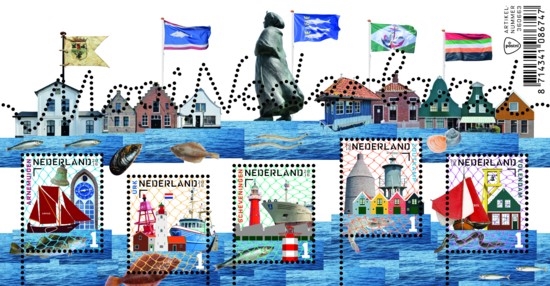 |
|
23-05-2016 (3): Photographer Ed van der Elsken: tram Ed van der Elsken (1925-1990) was a Dutch photographer and filmmaker. Although feminin beauty is the main theme of the photographs on the stamp sheet, the first stamp of the sheet also shows a tram, probably an Amsterdam tram. Most of the photos on the Ed van der Elsken stamp sheet originate from his book EYE LOVE YOU (1977). Designer: Marco Stout and Evelyne Kramer print: offset, Cartor Security Printing, France paper: normal with phosphor tagging Size stamps: 36 x 25 mm Perforation: 14½ : 14½ Watermark: none Glue: synthetic Value: 10 x 1 Circulation: 167,000 sheets Article number: 360665 Catalogue numbers: / Stanley Gibbons 3270 / Michel 3473 / Yvert Tellier 3395 / NVPH 3416 / Scott |
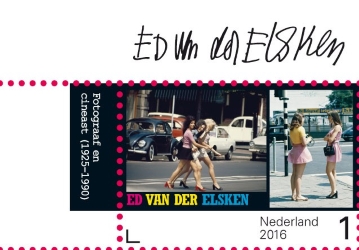 |
|
12-09-2016: 100th anniversary Schiphol Airport From a sheet with 10 stamps there is one stamp with a railway related subject. On the right you can see the rolling staircase leading down to the platforms of Schiphol Airport Light Railway. The Amsterdam–Schiphol railway (also known as the Westtak Ringspoorbaan) is an important 17 kilometre long railway line in the Netherlands that connects Amsterdam with Amsterdam Airport Schiphol, and allows trains to continue to Leiden, The Hague, and Rotterdam. The railway was opened by the Nederlandse Spoorwegen on 1 June 1986. The line prompted the opening of three new stations Amsterdam Sloterdijk, Amsterdam De Vlugtlaan and Amsterdam Lelylaan. A fourth station, Amsterdam Aletta Jacobslaan, was planned but it was never opened; today, the Metro station Henk Sneevlietweg is situated on the proposed site. In 1997 the Metro line 50 opened, running parallel with the line between Isolatorweg (between Amsterdam Centraal and Sloterdijk) and Henk Sneevlietweg (south of Amsterdam Lelylaan). De Vlugtlaan station was closed in 2000 as part of the project to open the Hemboog which would link Schiphol with North Holland. [source: wikipedia] Designer: Reynoud Homan print: offset, Cartor Security Printing, France paper: normal with phosphor tagging Size stamps: 36 x 25 mm Perforation: 14½ : 14½ Watermark: none Glue: synthetic Value: 10 x 1 Circulation: 118,500 sheets Article number: 361061 Catalogue numbers: / Stanley Gibbons 3324 / Michel 3508 / Yvert Tellier 3456 / NVPH 3449 / Scott |
 |
|
24-04-2017: King Willem-Alexander in Rotterdam From a sheet commemorating our king's 50th birthday is the stamp with part of the "Willemsbrug". In the lower left hand corner you can see part of Willems Railway Bridge, which spanned the Nieuwe Maas river from 1877 to 1994, when it was replaced by a railway tunnel. Only the liftable part of the bridge is left as a monument. The cover of the stamp folder shows the same image. Designer: Irma Boom Photograph: Vincent Mentzel print: offset, Joh. Enschedé Security Print, Haarlem paper: normal with phosphor tagging Size stamps: 36 x 25 mm Perforation: Watermark: none Glue: synthetic Value: 6 x 1 Circulation: 135,000 sheets Article number: 370463 Catalogue numbers: / Stanley Gibbons / Michel 3596 / Yvert Tellier 3513 / NVPH 3535c / Scott |
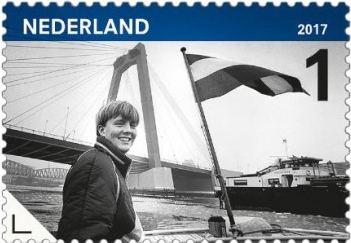 |
|
11-09-2017: industrial building in Rotterdam with tram rails. From a sheet about post-war reconstruction in The Netherlands is this stamp with the industrial building from 1951 at Goudsesingel in Rotterdam. Just below the number 1 you can see tram rails. Today, Goudsesingel is one of the main motorways within Rotterdam (a so-called city boulevard), with tram and bus lines. There are houses, shops, restaurants and a large supermarket. Also here is the post-war national monument "Het Industriegebouw" (1949, Maaskant, Van Tijen and Groosman), one of the first collective business buildings in Rotterdam. Designer: Ariënne Boelens, Rotterdam print: offset, Joh. Enschedé Security Print, Haarlem paper: normal with phosphor tagging Size stamps: 36 x 25 mm Sheet size: 108 x 150 mm Perforation: Watermark: none Glue: synthetic Value: 10 x 1 Circulation: 130.000 sheets Article number: 371161 Catalogue numbers: / Stanley Gibbons / Michel 3634 / Yvert Tellier 3571 / NVPH 3578 / Scott |
 |
|
19-08-2019: national public transport. This sheet shows several scenes with Dutch trains in them. Such as: From Zwolle to Stadskanaal by NS slow train (Dog's Head, also known as Monkey's Head or Mat '64, plan V) with graffiti painting), which entered service in 1964 but is no longer in operation. From Geuzenveld (city quarter) to Amsterdam Central by tram 13, Amsterdam articulated tram Bolkop (Municipal Transport Company GVB). In service from 1974 to 2003. From Den Helder to Maastricht by NS intercity (Double-deck Extended Interregio Material [DD VIRM]), rush-hour route. In service from 2002 to the present. Long rows of place names around the stamps refer to the four points of the compass: at the top of this stamp sheet and th one below are places from the north of our country, at the bottom are those from the south; left and right are western and eastern place names from the Netherlands. The place names are exactly at the level of the perforation. This has created a chain that connects all cities, villages and corners of our country by public transport. Whether these connections all existed in the order of the name lists is doubtful. Some connections never even existed at all. Designer: Thijs Verbeek print: offset, Joh. Enschedé Security Print, Haarlem paper: normal with phosphor tagging Size stamps: Sheet size: Perforation: Watermark: none Glue: synthetic Value: 12 x 1 national Circulation: sheets Article number: 391062 Catalogue numbers: / Stanley Gibbons / Michel 3839-3844 / Yvert Tellier / NVPH 3770-3775 / Scott |
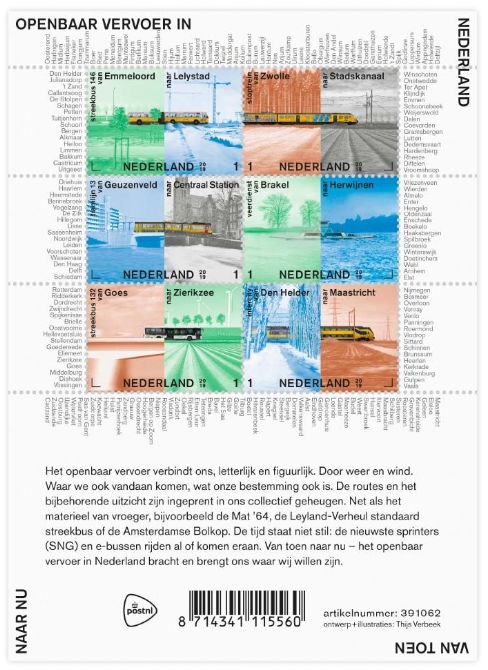 |
|
19-08-2019: International public transport. This sheet shows several scenes with Dutch trains in them. Such as: From Leeuwarden to Rotterdam by NS intercity (Intercity Materieel [ICM]), Front Runner (Koploper). In service from 2007 to present. From Amsterdam North to Amsterdam South by metro line 52 North - South line, Metro equipment M5 (Transport company GVB). From Amsterdam to Berlin by international NS train. NS locomotive series 1800 with an intercity car pulls German wagons (white with red band). In service from the 1990s to the present. From HS Station to Duindorp district by GTL8-II tram, tram line 12 (HTM Passenger Transport). In service from the late 1990s to the present. From Arnhem to Winterswijk by diesel-electric Arriva slow train Spurt, type GTW (GelenkTriebWagen). In service from 2013 to present. The Dutch Collectors' magazine Collect published an article on the public transport issue. It is in Collect number 100. Designer: Thijs Verbeek print: offset, Joh. Enschedé Security Print, Haarlem paper: normal with phosphor tagging Size stamps: Sheet size: Perforation: Watermark: none Glue: synthetic Value: 12 x 1 international Circulation: sheets Article number: 391062 Catalogue numbers: / Stanley Gibbons / Michel 3845-3850 / Yvert Tellier / NVPH 3776-3781 / Scott |
 |
|
24-06-2024: Overhead wire at Amsterdam Dam Square. This stamp is from a sheet of six postage stamps about André van Duin, a Dutch artist who is widely loved by the public. This particular stamp shows the overhead wire for the Amsterdam trams on Dam Square in the distance (on the right hand side). Designer: Sandra Smulders from Gouda print: offset, Joh. Enschedé Security Print, Haarlem paper: normal with phosphor tagging Size stamps: 36 x 25 mm Sheet size: 108 x 150 mm Perforation: Watermark: none Glue: synthetic Value: 6 x 1 national Circulation: 100,000 sheets Article number: 440762 Catalogue numbers: / Stanley Gibbons / Michel / Yvert Tellier / NVPH / Scott |
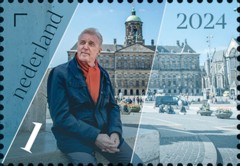 |